Everything you need to know about how to make kimchi! With this small batch recipe, you’ll find it not that difficult to make good authentic kimchi at home.
What is kimchi?
Kimchi (김치) is a collective term for vegetable dishes that have been salted, seasoned, and fermented. The its history goes back to ancient times. Originated from pickled vegetables, there are now hundreds of kimchi varieties in Korea. You can find some of the most common ones in my 15 easy kimchi recipes.
Over the last decade or so, Korean kimchi has gained a global recognition as a healthy probiotic food. It’s a good source of useful lactic acid bacteria, has excellent anti-oxidation and anti-cancer effects, and helps prevent aging.
This recipe is made with baechu (배추), known as napa cabbage, hence the name baechu kimchi. Because the cabbage is kept intact at its head, it’s also known as pogi kimchi (포기김치). Pogi means a “head” of a vegetable.
In late fall, Korean households make this type of kimchi in large quantity for their kimjang (or gimajang, 김장), an annual kimchi making event in preparation for cold months. I grew up watching my mother do her kimjang using over 100 cabbages with her friends in the neighborhood who rotated their schedules to help each other.
I usually make it with 5 – 10 heads (pogi) of cabbages at a time because we eat it every day. Also, I provide regular supply to my grown-up children. Both my mother and mother-in-law did that for us for a long time, so I am gladly continuing the tradition.
In Korean homes, there can never be too much of it. So many Korean dishes are made with well-fermented kimchi, such as jjigae, mandu, bibim guksu, kimchijeon, dubu kimchi, etc.
Buying napa cabbage (baechu)
For this recipe, it’s best to use a medium to large cabbage that weighs around 5 to 5-1/2 pounds with some light green outer leaves. When cut, a good cabbage has a nicely straight white part that’s not too thick as well as bright yellow inner leaves.
Salt for kimchi
Korean coarse sea salt (cheonilyeom, 천일염) is the best to salt the vegetables to make kimchi. It’s natural salt with a coarse texture that’s minimally processed. Commonly referred to as gulgeun-sogeum (굵은소금), meaning coarse or thick salt, this salt tastes good without bitterness, so it helps develop flavors in fermented foods.
When we first came to America, Korean sea salt wasn’t available, so we used American table salt to salt cabbages. Be sure to use less (about 1/4 less than the amount called for in the recipe) if using fine salt.
Kimchi seasonings
The taste of kimchi varies widely, depending on the quality, type and ratio of the seasoning ingredients. Each Korean household has its own recipes, often driven by the regional flavors of their hometown. I find myself making it differently each time.
Good quality gochugaru makes a big difference in kimchi. In addition to gochugaru (고추가루, Korean red chili pepper flakes), garlic and ginger, kimchi recipes typically call for various jeotgal (젓갈, salted seafood) for the distinct pungency and depth of flavors and to aid the fermentation process. Saeujeot (새우젓, salted shrimp) and myulchiaekjeot (멸치액젓, fish sauce made with anchovies) are the most common ones. Read more about these ingredients in my Korean Pantry Seasoning Ingredients.
Sometimes, I also use fresh shrimp which is my mother’s secret ingredient for adding extra freshness to the kimchi flavor. If you can’t find saeujeot in your area, consider using some raw shrimp instead.
If you want to make vegan kimchi, skip shrimps and swap fish sauce with soup soy sauce (gukganjang, 국간장). Or simply check out my vegan kimchi recipe.
How to make kimchi
To help you start making kimchi at home, I came up with this recipe using one head of napa cabbage. Start with one, and then move to 2 or 3 by doubling or tripling the recipe.
It typically starts with salting the main vegetable. For this pogi kimchi, you need to cut the whole cabbage in half lengthwise, and then into quarters. If you’re using 2 small cabbages, cutting in half should be enough.
Then, thoroughly bathe each cabbage half/quarter in the salt water one at a time. Using the other half cup of salt, generously sprinkle salt over the thick white part of each leaf. This process makes sure the white parts get evenly salted,
Meanwhile, make a kimchi paste by mixing all the seasoning ingredients, and then cut the radish into thin matchsticks and mix well with the paste. The rest is easy – rub a small amount of the radish mix over each cabbage leaf, mainly the white part.
How long does it last?
Although you can start eating your kimchi any time, it needs about two weeks in the fridge to fully develop its flavors. It will continue to age in your refrigerator and will be delicious for a couple of months, when the healthy bacteria count is the highest. It can last much longer than that, turning very sour over time.
Watch how to make it
More kimchi recipes
For more Korean cooking inspirations, follow along on YouTube, Pinterest, Twitter, Facebook, and Instagram.
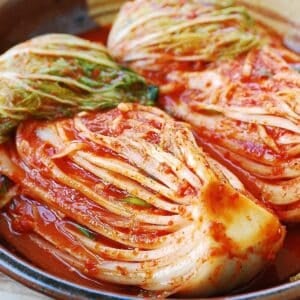
Ingredients
- 1 large Napa cabbage, baechu (배추), about 5 to 6 pounds, or 2 small (about 3 pounds each)
- 1 cup Korean coarse sea salt, gulgeun soguem (굵은소금)
- 5 cups water
- 1 pound Korean radish, mu (무)
- 1/4 large Korean pear (배) optional
- 3 - 4 scallions
- 1 piece dasima, 다시마 (dried kelp), about 2 to 3 inch square) - optional
Seasonings
- 1 tablespoon glutinous rice flour, chapssal garu (찹쌀가루)
- 1/2 cup gochugaru, 고추가루 - adjust to taste
- 1/4 cup saeujeot, 새우젓 (salted and fermented shrimp), roughly chopped
- 3 tablespoons myulchiaekjeot, 멸치액젓 (fish sauce)
- 3 - 4 raw shrimps, about 2 ounces, finely minced or ground - optional
- 3 tablespoons minced garlic
- 1 teaspoon grated ginger
- 1/2 cup water or dasima broth
Kitchen tools
- 2 large bowls or pots 7 - 8 quarts
- a large colander
- kitchen gloves
- 3/4 - 1 gallon airtight container or jar
Instructions
- Cut the thick white part of the cabbage in half lengthwise. Then, slowly pull it apart to separate into two pieces. Do the same for each half to make quarters. Running the knife through all the way would unnecessarily cut off the cabbage leaves.
- In a large bowl, dissolve 1/2 cup of salt in 5 cups of water. Thoroughly bathe each cabbage quarter in the salt water one at a time, shake off excess water back into the bowl, and then transfer to another bowl.
- Using the other half cup of salt and starting from the outermost leaf, generously sprinkle salt over the thick white part of each leaf (similar to salting a piece of meat). Try to salt all the cabbage quarters with 1/2 cup salt, but you can use a little more if needed. Repeat with the rest of the cabbage quarters. Pour the remaining salt water from the first bowl over the cabbage. Set aside for about 6 - 8 hours, rotating the bottom ones to the top every 2 - 3 hours.
- The cabbages should be ready to be washed when the white parts of the leaves are bendable. It's okay to have a bit of resistance. Rinse thoroughly 3 times, especially between the white parts. Drain well, cut side down.
- Meanwhile, make the optional dasima broth by boiling a small piece (2 to 3 inch square) in 1.5 cups of water for 5 minutes, and cool. Mix the rice flour with 1/2 cup water (or optional dasima broth) and simmer over low heat, stirring occasionally, until it thickens to a thin paste, and cool. Yields about 3 - 4 tablespoons.
- Prepare the garlic, ginger and saeujeot. Combine all the seasoning ingredients, including the rice paste and about 1/2 cup water (or the optional dashima broth), and mix well. Set aside until the gochugaru dissolves slightly and becomes pasty.
- Cut the radish and optional pear into matchsticks (use a mandoline if desired), transferring to a large bowl. Cut the scallions diagonally into about 1-inch long pieces. Add the prepared seasoning mix to the radish, and mix well by hand. Throw in the scallions, and mix everything lightly. Taste a little bit. It should be a little too salty to eat as is. You can add salt, more salted shrimp or fish sauce, as needed. Let it sit for about 30 minutes to allow the flavors to meld nicely.
- Cut off the tough stem part from each cabbage quarter, leaving enough to hold the leaves together. Place one cabbage quarter in the bowl with the radish mix. Spread the radish mix over each leaf, one to two tablespoons for large leaves. (Eyeball the stuffing into 4 parts and use one part for each cabbage quarter.)
- Fold the leaf part of the cabbage over toward the stem and nicely wrap it with the outermost leaf. Place it, cut side up, in a jar or airtight container. Repeat with the remaining cabbages. If you have loose large leaves, you can use them to cover the top of the kimchi (see note 1). Once all the cabbages are in the jar or airtight container, press down hard to remove air pockets. To collect any remaining seasoning, rinse the bowl with 1/2 cup of water (or the remaining optional dasima broth), and add it to the kimchi container. Close the lid.
- Leave it out at room temperature for a full day or two. It can be longer, depending on the weather and how fast you want your kimchi to ripen. Then, store in the fridge. (see note 2)
Notes
- You can cover the top of the kimchi with large outer green leaves (as I did in the video) if available. Some people also use a plastic wrap to cover. But, this is not absolutely necessary, especially for this small batch of kimchi.
- Although you can start eating it any time, kimchi needs about two weeks in the fridge to fully develop the flavors. It maintains great flavor and texture for several weeks.


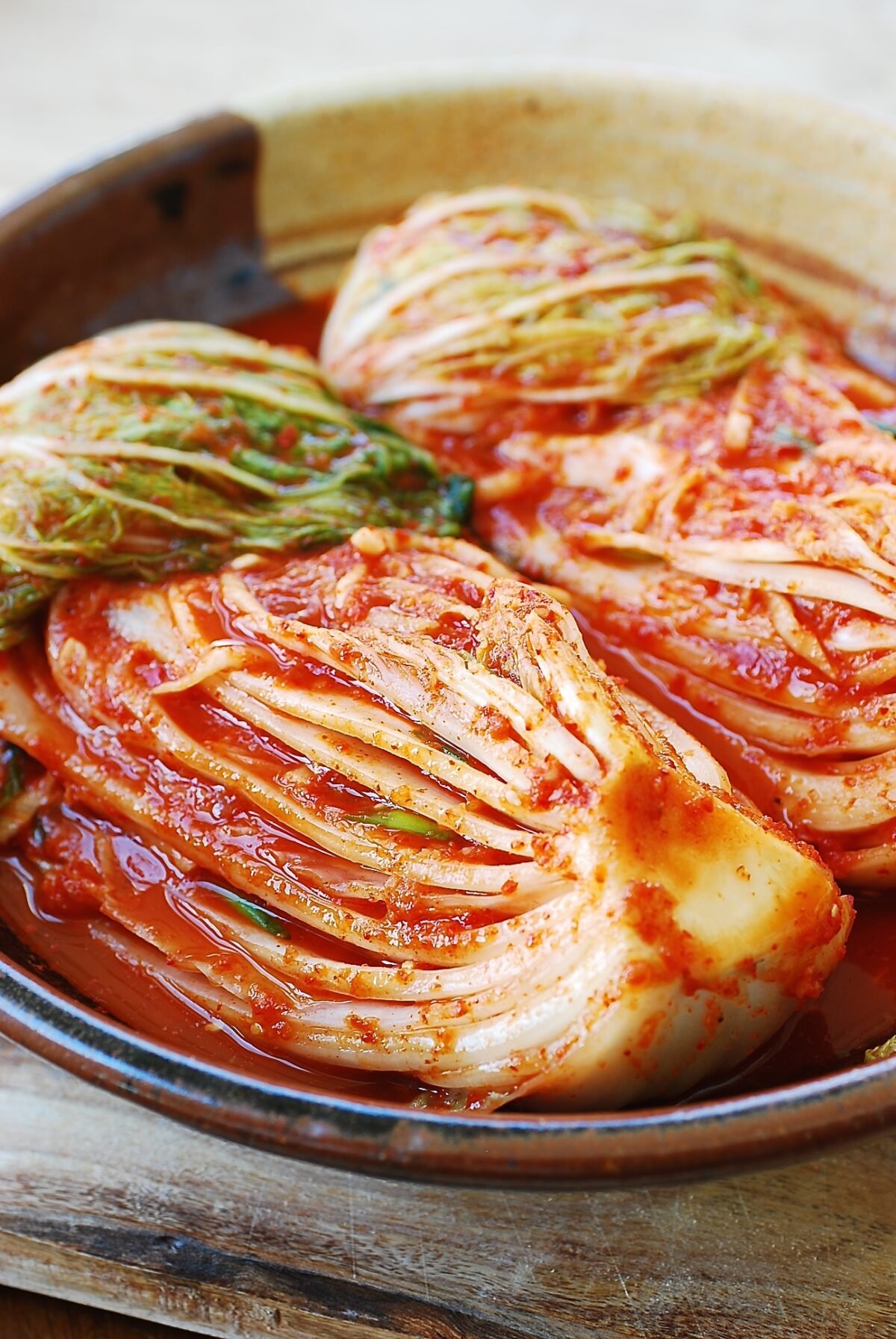
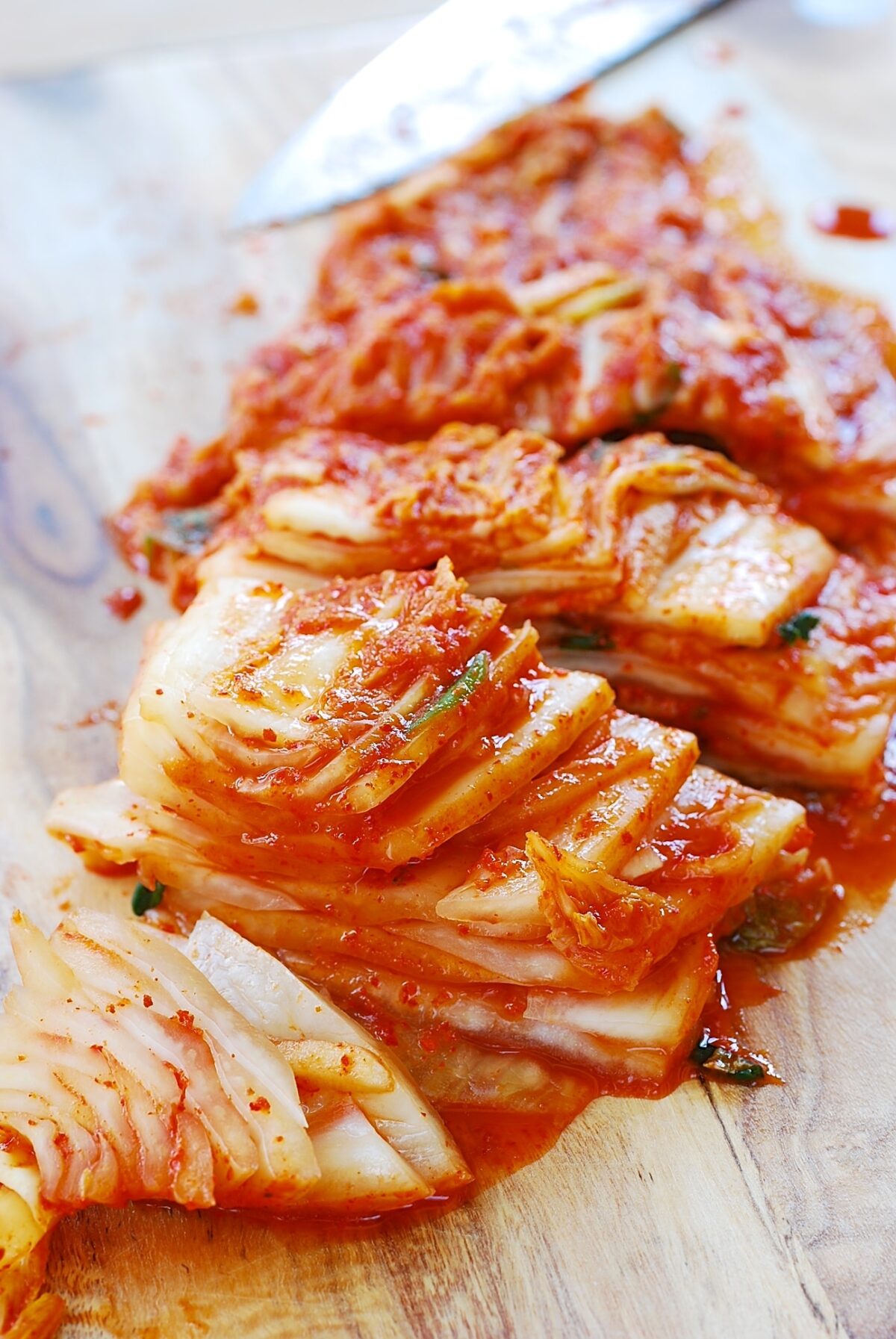
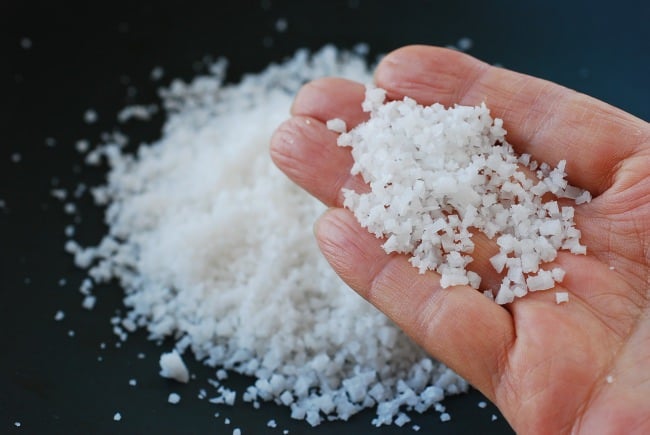
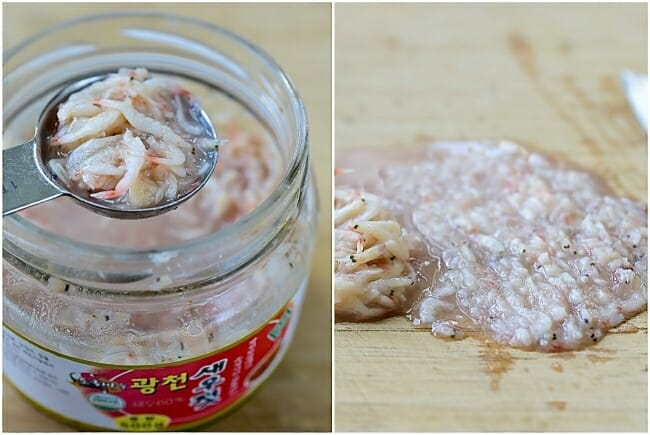
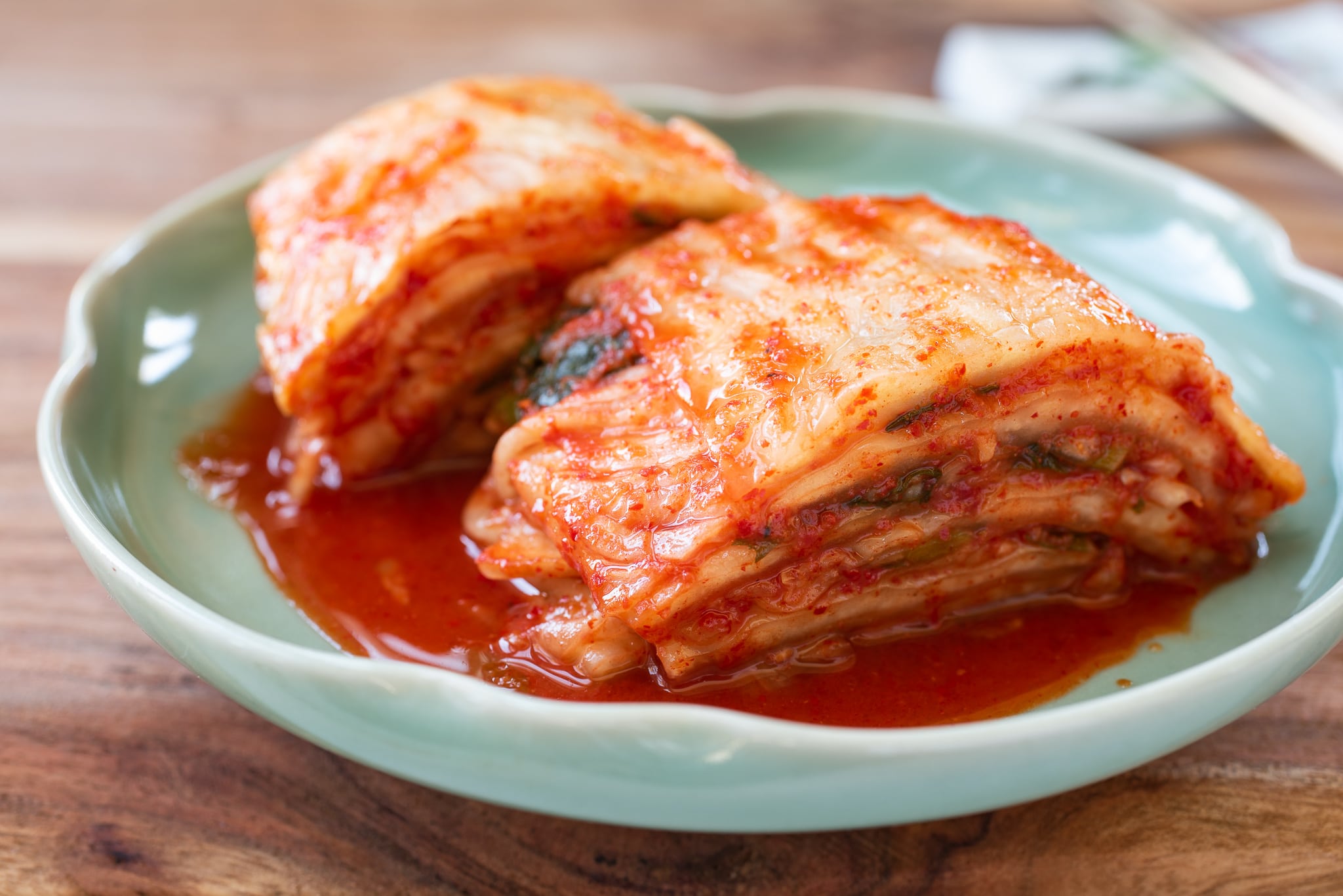
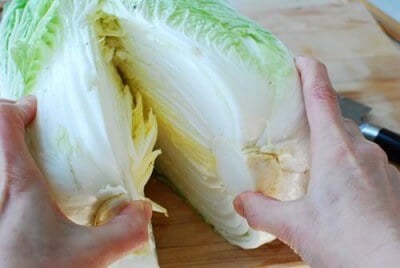
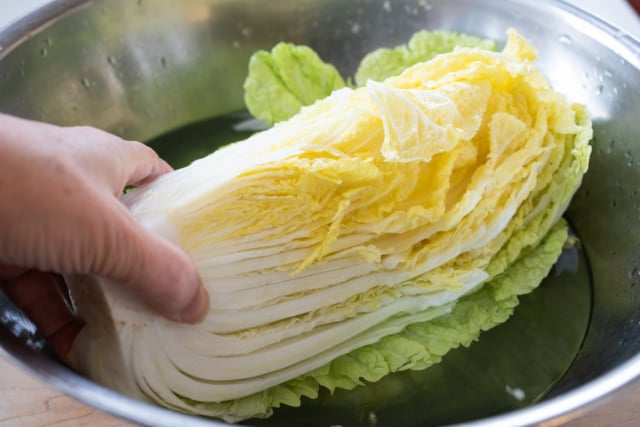
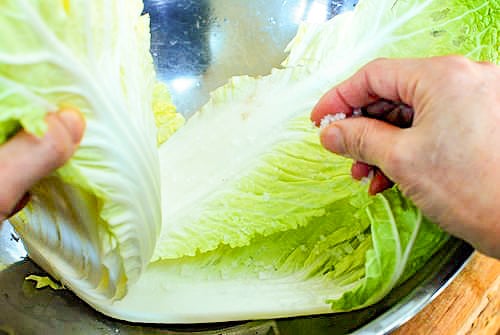

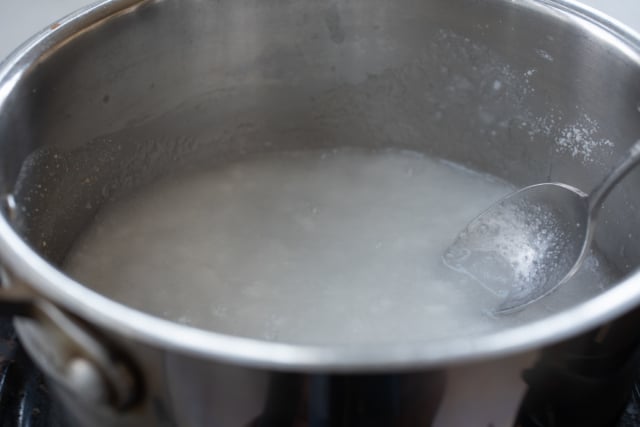
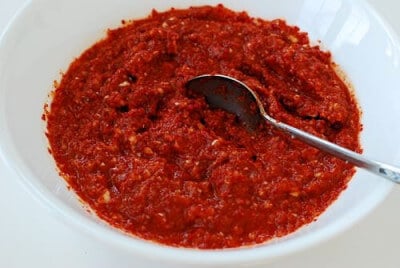
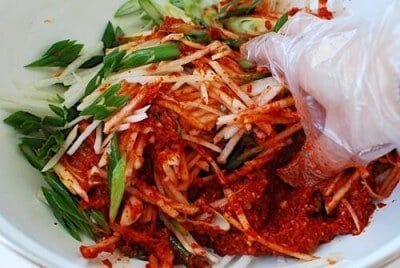
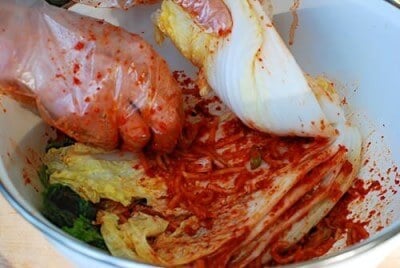
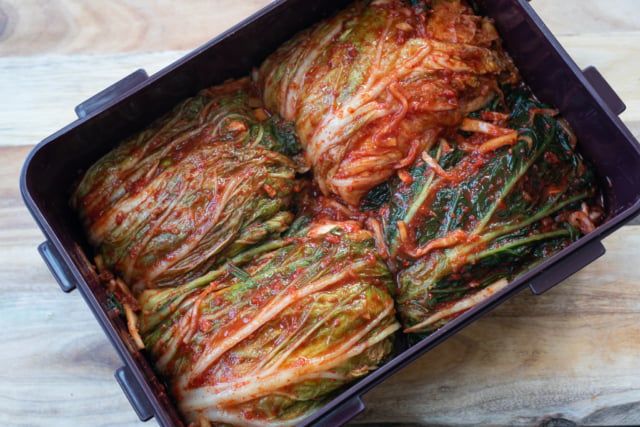


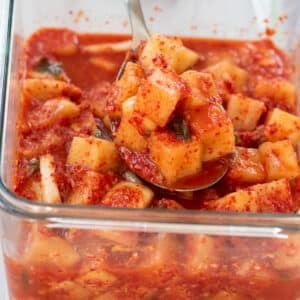
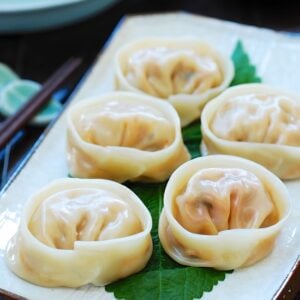













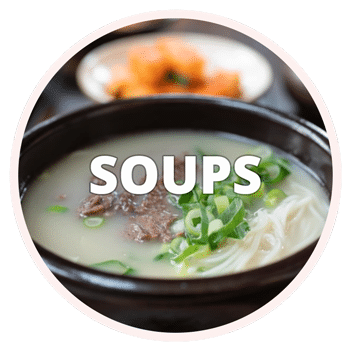



Veronica Sprague says
I really appreciated the video tutorial of this recipe. I’ve made it several times and I don’t always have all of the ingredients or the exact measurements but it always turns out great! It’s best after a few months in the fridge in my opinion 😉
Hyosun says
I’m glad to hear the video is helpful. Sounds like you got your kimchi making down. Old kimchi is so good!
Collet Crabill says
Thank you for this fabulous recipe! I’ve made it a couple of times, but I was wondering if I can add a new batch to the small amount I have left in the fridge. I’m thinking of pulling out the older amount and putting it on top of the new batch, I don’t have enough space for two large containers.
Hyosun says
You’re welcome! Thanks for using my recipe! It should be fine. Depending on how much and how sour old kimchi is, it might facilitate the fermentation of the new kimchi.
Anna Feng says
I would like to make an even smaller batch with just half a cabbage. Is it possible to cut the ingredients quantities in this recipe in half and achieve the same results?
AF says
Can I take this recipe and divide all the amounts by 2 so I can just do kimchi with half of a cabbage?
Hyosun says
Yes you can, but you’d have to go through the same steps. You might as well make the whole cabbage. Kimchi lasts for a long time.
Cece says
Hello! I accidentally missed the step to pour the brine water back over the cabbage after dipping. So it soaked for 8 hours with only the half cup of salt I sprinkled on the leaves. Will it be ok? Thank you!
Hyosun says
As long as the white parts of the cabbage were salted (should be bendable – a little resistance is okay), it should be okay. You can make the stuffing a bit saltier if it wasn’t salted enough through brining.
Thanuja says
Hi can make this without the fermented shrimps please that’s the only ingredient am missing
Hyosun says
Yes! Just use more fish sauce and/or salt to taste.
Steve Webb says
Fantastic recipe… thanks so much!! Very clear instructions.
My Daughter discovered Kimchi when she lived in Japan.
I have always had stomach trouble … old rock and roll guy… too ,inch junk food! I started eating store bought kimchi 6 months ago… it really helps to get a healthy gut… then l looked for recipes as the stores over here in Finland do not have it on the shelves all the time… not a well known food. Today l make my first batch with your recipe… it is so good at the tasting stage. You are my new go to teacher!! Bless you and your loved ones.
Steve Webb says
Today l am making the second batch….. I have just eaten the last bit from the first time l tried your wonderful recipe… it is soooo good! I was a bit lazy and did not grate the ginger and my vegetables were not chopped fine enough… but … after a few weeks it tasted amazing. Now l have taken much more care over the whole process….watched your video many times .. you are a great teacher. My wife is laughing at me..calls me the ‘Cabbage Boy’ ! I don’t mind.. one question… Korean Radish…so hard to find. Is there anything that might be a suitable substitute?
All the best to you and thanks so much for a great new taste experience .
Perrine A. says
Hi there ! French girl here ! When I don’t have the opportunity to buy Korean radish, I use black radish at the grocery store. I don’t know if you have that kind in Finlande but I find it great as a replacement !
Grace K says
Hi Steve, in Scandinavia you might be able to substitute the radish with kohlrabi? It has a nice sweet flavor and is less harsh than radish. Good luck and congratulations on your kimchi adventure!
Sandee says
You can also use daikon (Japanese) radish.
Alex says
I’m looking for a more traditional kimchi recipe like my papa used to make. I remember him burying jars in the yard and storing them in a dark back unused room for long periods of time when we were kids to remember ferment properly.
Today’s kimchi tastes like it’s got sodium bicarbonate in it which is off to me. It isn’t right.
Anyone able to get into the real processes of the kimchi fermenting making of it all? I want the real deal just like grandpa made. It was the best!
Bcweed pen says
Traditional Kimchi is a timeless classic! I absolutely love the rich, bold flavors and the depth of history that goes into making this Korean staple. The process of fermenting the cabbage and spices is a true labor of love, and the results are worth every bit of effort. There’s just something special about the way the flavors develop over time, becoming more complex and delicious as the days go by. I often enjoy it as a side dish with rice or as a topping for my favorite Korean dishes. It’s a taste of tradition and culture in every bite!
Michelle says
Years ago, my local Korean market raised the prices dramatically on their kimchi. I decided to save some cash and try to make it myself. I have been using this recipe ever since. This recipe is great! Very easy to follow and the flavor of the kimchi is excellent.
My one tip is to really make sure to rinse the cabbage well after salting. The only time my kimchi turned out poorly was because I rushed this step, leaving me with an overly salty kimchi. My fault entirely but now I check the cabbage by tasting a small amount after rinsing just to be sure.
Thank you for making Korean cooking accessible! I was intimidated to try Korean cooking but your blog has made it easy to enjoy Korean food at home. Thank you!
Hyosun says
Happy to hear you’re making your own kimchi and my recipes are helping you with Korean cooking! Yes, it’s important to rinse the cabbage really well.
Peter Johnson says
Thank you Hyosun for being a great teacher.
It is a really picturesque setting.
I have made your Nappa cabbage Kimchi now three times and now doing four at a time.
Sharing with you some curiosity driven experimentation.
I have made it non seafood/non dashimo.
Put in some Tamari sauce for flavour instead which has still worked and tasted great.
Also increased the fresh grated ginger a fair bit as it is a favourite.
These have been a hit for all of our large family.
I have been putting them one and a half quarters into glass jars and opening them and pushing down around the inside with the handle end of a wooden spoon morning and evening to release the trapped fermentation gas to combat the rising and overflowing water.
I have cautiously experimented with going a day or two longer before refrigerating.
I also found that I needed to be more thorough with the fresh water rinsing like you showed in your teaching video to tone down the salt
Following your teaching makes it really enjoyable to make Kimchi.
Looking forward to exploring more of your recipes
thanks again
Peter Johnson in South East Queensland, Australia
Jimbo the Owl. says
I’d just like to ask if fruit can be added like apple or pear. Also, is there a decent substitute to guchugaru as I live in the UK and we don’t seem to have a very large Korean community here hence gochugaru is difficult to purchase. I have read gochujang can be substituted but I’m sure brands will differ in strength and quality.
Shawn J Tinlin says
I am lucky that in our relatively small community, we have a number of Asian supermarkets so gochugaru is readily available. But before realizing this I did order some on Amazon for a very reasonable price so you might want to try that.
Ross says
There are sources for red pepper flakes in various areas of the UK. Depending on where you are there are a few large Oriental cash and carry stories. Some carry specifically Korean red pepper flakes and others carry Chinese varieties. If you are near Milton Keynes there are two locally. There are stores in Northampton, Nottingham etc and there are multiple places in London. New Malden is home to the largest South Korean community in Europe, and it serves as a commercial and cultural hub for Koreans living in the UK. Ethnic Koreans account for around one third of the area’s population. Kent has a significant Korean population as well.
Diana H. says
I have made this Kimchi a few times now. I left one batch in the fridge for several weeks and it made the best Kimchi Stew I have ever tasted.
Angelica says
Hi Hyosun, lovely display for cooking. Today I made a medium sized nappa cabbage. I even got green mustard leaves. Loved the making of it. It felt good. It was delicious! Now the waiting time of a month. Yet I’m planing to leave it at room temp (some cold in winter here in London). I’ll let you know how it went.
Hyosun says
Happy to hear you enjoyed making kimchi! Room temperature may be still too warm for kimchi to be left at for a month, so check in every few days and see if it reached the ripeness you desire. Should put in the fridge after that. It will continue to ferment in the fridge.
Mel says
Extremely clear recipe and my favourite one so far, makes a perfect amount for one household and doesn’t require the destruction of my entire kitchen to create haha. I will recommend this one to my friends
SteveO says
How big is “one large Jar”
Hyosun says
3/4 – 1 gallon airtight container or jar – See the kitchen tool section in the recipe card.
Mai says
Hi, I wanted to ask if the gram equivalent could be provided for this recipe for us non US folk? been trying to make kimchi but i’m worried I may mess up the salt amounts if I google the equivalents
Hyosun says
oh sorry about the late reply. I use Korean coarse sea salt, 1 cup of which weighs about 180 grams.
Dutch says
Thanks for this reply Hyosun, I was looking for this exact information. I have access to a pretty good Asian grocery owned by Koreans but have a good bit of fine sea salt I’ve been trying to use up so wanted the weight rather than volume.
I might add, as an avid baker, weight (or mass) measurements are super helpful rather than volumes for most ingredients. Mass takes out a lot of the variations of humidity and coarseness/fineness of ingredients that volumes can make problematic.
Thanks so much for everything you do here. I’ve fancied Korean food for quite some time but a recent trip to Atlanta where my wife and I spent about half of the time in Gwinnett County’s K-Town has had me cooking almost nothing but Korean food for the past month.
Risa says
Can you explain the difference between this kimchi recipe and the ones that call for it to be submerged in brine while fermenting?
Hyosun says
hmm not sure which recipes call for it to be submerged. Traditional kimchi doesn’t need to be submerged in brine entirely. It will release some liquid during fermentation but not enough for the entire kimchi to be submerged.
kor in USA says
it is good recipe with pictures, I would say 포기 김치 is kimchi with whole cabbage instead head. head meas use head of cabbage without top green wide leaves.
some people may misunderstand of head of cabbage.
Susan says
Hi
A head of cabbage refers to the whole cabbage, like a bunch of carrots, a head of cabbage. This is the English meaning, but of course it may be different in another language.
Hope this has been helpful.
Donald G says
I love this recipe! However, I love in South Dakota and there are few to no stores here that sell quality Asian food ingredients. Is there an online store that you recommend? Thank you so much for the time you put into your videos.
Hyosun says
Depending on what ingredients you’re looking for, there are quite a few. I recently posted Korean pantry staples where I talk about on-line sources. Hope you check it out.
Mr WyreFull says
I just finished making this ! I buy it a lot so much so I figured I would make it myself so thanks a bunch for the recipe!
So I omitted the fish however I did use the fish sauce and I used Sea Kelp Delight Seasoning to make the broth. In my excitement I neglected to follow the directions! I cut each individual leaf into squares (ooops!) It is all in jars now! I think I might purchase the rubber canning lids? I am concerned about air getting in? Can I process these in the pressurizer?
Hyosun says
Kimchi storage is not canning, and if you closed the lids, it should be okay. Store them in the fridge after a day or so.
Lorenzo says
Thank you!!!!
Jim Arnold says
What steps do I need to take to make this shelf stable. More clearly, can I water bath can it afterwards? I would like to make a large batch and then can it and store with my other home canned foods. Do I need to somehow stop the fermentation process before doing so?
Hyosun says
Sorry I somehow missed your question until now. Kimchi is not a shelf stable food. It should be kept at low temp or in the fridge. I certainly have not done it. Sorry not being helpful..
Lanaux says
I have just made this recipe for the second time, and it looks like it is ready for the refrigerator! This recipe ROCKS and your explanations are fantastic! I do it vegan, and everyone who has tried it has LOVED it. My mom used to make kimchi when I was a child; then, I didn’t like it; now, I adore it and eat it every day, and think of her both when making it and eating it.
Thanks a million times!
Michael says
This is the best kimchi recipe I have tried. It is much less salty, the cabbage stays crunchy and the flavour is unbelievable, even after only a few days. So good. I used fresh shrimp and no salted shrimp as I could only find a large and expensive jar of it in my Korean grocery store. Also they only had instant dashima which was mainly MSG so I used Japanese dashi packet. So good. I think I will make more this weekend as I already ate half a cabbage!
Hyosun says
Great to hear that! Thank you!! If your Korean market stock up small jars of salted shrimp, try it. It will make your kimchi taste even better.
Brenna says
Thank you so much for this recipe! I made it for the first time about a month ago, and it turned out amazing! I’m making it again today, and I’m so excited! Please continue to share your recipes with us 😊
Cellyn says
Hi Hoysun, thank you so much for your sharing. May i know can I use bonito stock instead of dashima?
Hyosun says
Sure you can. It will add some umami taste.
Cellyn says
Thank you for your reply! 🙂
I would like to ask can I cut them into bite size while using this recipe instead of mak kimchi recipe?
I’m not sure what is their differences.
Hyosun says
You can. The difference is the radish stuffing. We don’t usually make it for cut up kimchi, but you can mix the radish stuffing with cut up cabbage if you want to. You can also half the mak kimchi recipe if your concern is that the recipe uses 2 cabbages.
Mel & Zoie says
Thank you so much for making this video – you are wonderful Hyosun! I came across your video earlier this year and planted a patch of Napa cabbage just to create your kimchi recipe. We harvested the first cabbage today and are very excited and patiently waiting for our cabbage to soak. My daughter and I look forward to making your recipe our yearly tradition here in NYC. Mel & Zoie
Hyosun says
Wow growing your own napa cabbage? How cool is that! Hope your kimchi turns out well.
Sue says
It is very hot here in NYC lately and it is over 80 degrees in my apartment. After I made the kimchi, I left it to ferment for 8 hours and placed it in the fridge. I tried it after a week, and it is a bit salty and bitter, no sourness. Will it still ferment in the fridge? I am willing to let it ferment in the fridge slowly as I have other kimchi to eat.
Hyosun says
Yes it will ferment in the fridge, but it takes much longer than a week to become sour. Depending on the salt level, it should taste ripe after 2 to 3 weeks.
novice kimchi maker says
hi there!
just made this recipe and it’s great! the only thing i would recommend however, is in the recipe, for the amount of salt, put down the amount of fine sea salt to use if people choose to use fine sea salt rather than Korean course sea salt. I made this recipe using fine sea salt, but used the amount listed for Korean course sea salt (thinking not a huge difference would occur) and my kimchi turned out crazy salty. i had to go back and read through the entire directions before i saw that you had mentioned briefly to cut the salt by 1/4 cup if using fine sea salt. So maybe clarify that in the recipe so people don’t end up doing what I did, haha.
Other than that – it tastes great! thanks for sharing your recipe 🙂
Toby Powell says
What a beautiful video! So well explained and I love imagining how this would have been made all the time generations ago. My cabbage is currently in salt water underground it’s first brine – very much looking forward to trying it. I’m following your recipe to the letter. Thank you for sharing this!
Hyosun says
Hi Toby! Thank you! Hope you enjoy the kimchi making process and be rewarded with delicious kimchi! Thanks for coming by to let me know.
Lana McCarthy says
I am so happy and grateful to have stumbled across your website. This was my first time attempting kimchi and it came out perfectly! My only regret is that I didn’t double the recipe. I couldn’t stop eating it and it was gone too quickly!
I loved your detailed explanations and helpful video. I’ve already bookmarked a bunch of your recipes and can’t wait to try those too. Thank you for teaching us how to make such beautiful dishes!
Hyosun says
Aww I’m incredibly happy to hear that! You must be a great cook. Thank you so much for such kind words! You just put a big smile on my face. Hope you find many more recipes you like.
Joy says
I want to try this but can I use onion leeks instead of scallions?
Hyosun says
Not traditional, but sure you can use it. Try to chop it finely as they tend to have a tougher texture.
Janet says
Thank you for your recipe! I love it and all my family members live my kimchi 😊
Today I tried to double the recipe. My container (an E Jen) is now filled almost to the top and the liquid leaked out when I pushed in the inner lid and I have to use a bit of pressure to cover the outer lid. I checked every couple minutes there are still some liquid come out. I keep the vent closed and just use a kitchen towel to absorb any excessive liquid….
Is this ok?? Will it change the outcome of my kimchi?
Hyosun says
That’s great that you make good kimchi that your family loves! It sounds like you overfilled the container. Kimchi will expand as it ferments, so if it’s already overflowing that’s not good. You shouldn’t be absorbing precious kimchi liquid with a kitchen towel either. I suggest that you take some out either enjoy it as fresh kimchi or transfer to another container. It will shrink back when you put the kimchi in the fridge, but it will expand over time and might overflow unless you take some out to eat creating room. Hope this helps.
Janice says
Hi,
I first made Kimchi using your recipes in 2017. It tuen out well and my family n friend like it so much. However, this time the Kimchi turns out very salty, is there any way to savage it? Does the fermentation time affects the saltness. I left it for 2 days for fermentation.
Hyosun says
Sorry to hear that! Yes the saltiness will reduce slightly as kimchi ferments, but if it’s too salty, try cutting up some Korean radish and add between kimchi quarters — about a half to a pound (1/2-inch thick, 2-inch pieces). It happens but try to think what you did differently this time, so it turns out not as salty next time. Hope this helps!
Gaby says
Hi, thank you for a really nice recipe! We just tried to make it and cant wait to taste it!
Two questions:we see that some of the kimchi still is above the liquid in the jar, is that ok or should we add a weight to press it down?
And is it important that the jar is sealed while fermenting?
Thank you and all the best from Norway!
Hyosun says
Hi Gaby! This type of kimchi is not meant to be submerged in liquid. Just press it down and keep it closed. Kimchi fermentation likes no exposure to air and low temperature, so keep it in the fridge after a day or two. I visited Norway in 2019, and loved it! Can’t wait to go back.
Gaby says
Great, we’ll try that then! We have little B&B with organic homemade breakfast and home made cheese, hope you pass by here the next time:)
http://Www.skiferud.no
Hyosun says
Awesome! I’ll remember it for my next trip.
Cristina says
Thank you for sharing this Kimchi recipe. I tried to make this recipe last December 2020 but my Kimchi didn’t have the acidic taste. What is the possible reason for this issue. Thank you
Hyosun says
Do you mean it didn’t taste acidic when you made it? It takes 2 to 3 weeks to develop the flavors and longer to taste really sour. If you meant that it didn’t start turning sour after 2 to 3 weeks, it might have been too salty.
Agnes says
Hello, I have made kimchi before but this is my first time using your recipe (the difference is I added the korean salted shrimp and korean anchovy sauce. It’s been one day fermenting in room temperature and i notice that the top layer of the kimchi has a dark/black color. I never had this happen to my kimchi before when I did not use those 2 ingredients. Is it normal to have this dark red color? I can also send you a photo of it if possible. Thanks!
victor da says
I watched 8-10 different videos teaching how to make proclaimed authentic kimchi. This one is definitely the best.
Hyosun says
aww thank you!!! You made my day!
Petr Kubik says
My salted shrimp paste container says it must be cooked before eating. How does that work with using it in kimchi? Is the assumption that fermentation somehow makes it safe for consumption without cooking?
Hyosun says
Hmmm sorry not sure what salted shrimp paste you’re talking about. Korean salted shrimp is salt fermented and not required to be cooked.
Alessia says
Hi! I have some questions:
I’m Italiano so I don’t have some ingredients here like korean radish and dashima, can i can’t use them?
I don’t have saeujeot, too. Can I use anchovies minced to replace shrimps?
Hyosun says
How about if you try this recipe that doesn’t require radish and saeujeot? https://www.koreanbapsang.com/baechu-geotjeori-fresh-kimchi/
Italian anchovies are totally different from Korean salted shrimp or anchovies, but I’m sure using it a little won’t hurt. It will add some savory flavor to kimchi.
Amanda Moon says
Thank you so much for sharing your recipe! My kimchi turned out delicious and I am going to make some more tomorrow.
One question though, I was always told to add onion to my kimchi but I noticed your recipe did not include it. Is there a reason why you don’t add it in your recipe. Just curious. Thank you!
Hyosun says
Great to hear your kimchi turned out delicious! It’s a matter of preference. However, if you use too much onion, enzymes in onion can soften the cabbage texture over time. Remember we use onion in marinades to tenderize meat. It should be okay for a small batch that will be eaten in a short period of time.
Olivia says
This is the second time I’ve made this recipe. I didn’t actually have success the first time. I had to leaves unexpectedly for 3 weeks after putting it into the fridge, and when I came back it had grown a mold. I think the cabbage had come into contact with air, but I can’t be sure. However, I enjoyed the raw product so much and process of making it that I tried again today. It was much easier and faster the second time around, and still tastes incredible before even fermenting! Hopefully it all goes well second time around. I have a more appropriate fermenting vessel now 🙂
Tamara says
My husband LOVES kimchi. My son has celiac. Would you be able to help me create a yummy GF alternative? I’d love to share with my entire household. Much thanks!!
Hyosun says
Hmm I’m an expert on GF, but what ingredient in this recipe you think has gluten?
Sherry Wellborn says
I wonder if the troubling ingredient is glutinous rice powder. My understanding is that glutinous rice is synonymous with sushi rice and that it does not contain wheat/rye/barley gluten, so is not an issue for those with celiac disease.
I worked with Korean Americans in the late ’70s. They introduced my to kimchi. I have tasted many versions since and never encountered the flavors of that made by my co-workers. I have hope that this recipe will get me to those flavors once more. Thank you.
Hyosun says
Hi Sherry! It’s not the same rice as sushi rice. Glutinous rice is stickier and chewier than short grain/sushi rice. However, you’re right it doesn’t contain gluten. I hope this recipe gives you something close to the kimchi you remember from your friends in 70’s.
Erica says
I love this recipe, thank you! My Korean friend gave me kimchi in March 2020, and it was the first time I ever tasted it. I wanted to try and make my own and found this recipe! It turned out delicious! My question is how long can I keep an opened jar of saeujeot in the refrigerator? Does it need to be used within a certain amount of time after opening, or can an open jar be used for up to a year or longer? The date is still ok, but I wonder if the quality and flavor go bad if the jar is open for too long. I don’t want to used bad saeujeot and ruin my next batch of kimchi!! Thank you 😊
Hyosun says
So happy to hear your kimchi turned out delicious! Freeze it! It will keep well for a long time, easily for months, in the freezer. Saejeot won’t actually freeze, so you can simply take some out to use when needed.
Ani Long says
Absolutely delicious!
Tom Bolt says
I am on my second attempt after my first relative success out of four prior which had to be thrown away. I have had to modify the recipe which I am sure does not help. For the shrimp, I have used shrimp paste but reducing it to one teaspoon. I will increase to an additional half-teaspoon this time. I missed using the course Korean sea salt, I ground it when I guess I should not have. As of now, I do not have the skill to tell if I over brined the cabbage or underbrined. I can double the cabbage which resulted in about two hours. I am finding this simple task to not be so easy. I have made saurekraut successfully but for some reason accomplishing the craft of Kimchi is not as easy. If I remember I will return with this most recent attempt 14 Nov 2020, saturday.
JULIA says
I’ve made mak kimchi many times, but I am excited to finally make it the “real” way. I have an onggi that I have never used before, and I want to use it for this kimchi. Once it is fermented, do I leave the kimchi in the onggi or transfer to another container? Thanks!
Hyosun says
oh sorry I missed your question. Kimchi used to be stored in onggi and kept underground for the cool temperature while not freezing in winter. But, you should ferment kimchi in the fridge, in which case onggi might not be practical.
Darek says
I’ve been making kimchi for a couple of years but I’m still learning and trying to keep improving my already good kimchi, so thank you for this professional recipe.
I am thinking only of one point. After 2 days of pickling, cut the cabbage quarters into slightly smaller pieces so that they can be put into liter jars that go to the refrigerator. Do I lose any quality and aroma by doing this? Is it better to try to squeeze whole quarters into jars and put them in the refrigerator like this?
I would be grateful for your opinion.
PS. Does adding fresh shrimp pose a risk that toxic putrefying bacteria (so-called botulinum toxin) may be formed?
Emily says
Hello! I have a ton of cabbage from a farm i help at this year and was looking for recipes to preserve it and found this one and i really want to try it! But i have a question i didn’t really see addressed in the comments… i wanted to can/seal it in mason jars so it doesn’t have to take up my whole fridge. But can you can something that is fermented? If i can sauerkraut it says to hot pack it so i assume heating it to temp stops the fermentation but can you do this with kimchi? I have so much cabbage 😭
Teri Hruska says
i noticed you did not get a reply….I hope that you found an answer because if you can by water bath or pressure cook, the high temperature will destroy the beneficial properties. The taste might not change so much but please don’t do it. just keep in jars with liquid covering. I put quartz stones in my jars to keep air away from contact. I’ve boiled the stones and then push down to create the liquid barrier.
Jeffrey Damal says
This recipe is my favorite. I find the process of making kimchi very relaxing & soul nourishing during the pandemic. Thank you! I have tried adding seasonal fruit like apple and peach that adds a different sweetness. This recipe is a great base to experiment with other ingredients. It is fun to think of Kimchi as a verb!
Denis Caissie says
This was perfect. I’ve been trying to find commercial kimchi but they all make it super spicy just for the sake of hot. This recipe was the taste I remember from my Asian travels. I had all of the ingredients except for the fish sauce for my first batch. Next time I’ll add the fish sauce. The perfect balance of taste. Thank you so much for posting this.
Sophia says
I made kimchi for the first time and it turned out great!! So much better than from the store.
I modified it a little since I couldn’t find all the ingredients: used shredded carrot instead of radish, and no shrimp. I did use fish sauce and the rice flour, which I made myself by putting glutinous rice in my spice grinder ( it worked!)
Elizabeth says
Wow this looks super flavorful and delicious! Can’t wait to try this!
Melissa says
I have followed your recipe twice! It’s perfect and so well explained. 1,000x better and WAY cheaper than store bought.
James says
Difficult to make good authentic kimchi at home.
Hyosun says
It will get easier each time you make it.
Debbie says
Hello! The first time I made this kimchi recipe it was delicious! I recently made it again. It’s been in the fridge for almost 2 weeks. I tasted it today and I’m worried that it may be too salty. Is there anything I can do to save it?
Debbie says
The first time I made this kimchi recipe it was delicious! I made a 2nd batch recently and it has been in the fridge almost 2 weeks. I tasted a little and I’m afraid it may be too salty. Is there anything I can do?
Hyosun says
Oh do you know what you might have done differently the second time around? You can leave it out to expedite fermentation because the saltiness will reduce as kimchi ripens. I wouldn’t recommend adding anything at this point, but for some reason if it’s very salty then just cut up (thinly slice — see my mak kimchi recipe) some Korean radish and place them in between the cabbage quarters and the leafy part of each quarter. Let it ferment for 3 to 4 days and see how it is. Hope this helps.
Alyona says
Hello!
Tell me please why kimchi changes color to become dark and ugly?
Hyosun says
It should not have. Kimchi should turn brighter as it ferments. What kind of chili pepper powder did you use? Or any dark ingredients?
Jackie says
Hi I made this last night! However I just realised I forgot to rinse the bowl with 1/2 cup of what and pour it on the kimchi….should I do that now or does it not matter?
Also should you not open the lid to release some of the fermentation gas while it is fermenting?
Thanks!
Hyosun says
oh not a big deal. Don’t add water now. Hopefully by now you have it in the fridge, in which case it should be okay. But if you’re concerned, you can open and check.
Austin says
This is so amazing!! however I am having many troubles along the way in the critical parts of making the kimchi. Im not sure of the right amount of salt to put in when salting the cabbage and if thats why the cabbage isnt wilted enough, but then I wonder how much should the cabbage bend? 🙁
Jay says
My kimchi is on the counter for 2 days but I son’t see any bubbles yet…Should I wait for bubbles before putting it into the fridge?
Hyosun says
No need to wait until you see bubbles. Slow fermentation at low temp is better for kimchi after a day (warm weather) or two.
Jay says
Hi, I made the Kimchi ferment 2 days ago. I still have it sitting on my counter in order to ripen it. I have it in a glass (Corningware) lidded casserole dish. I haven’t seen any fermentation bubbles. Should I be seeing them by now…How long can I leave it on the counter…I’m in Florida but I keep my house pretty cool…65 degrees most times…but I am assuming the Kimchi needs warmth not cold to start the fermentation… Please instruct me as I know not where I tread here, lol! Thank you
Hyosun says
I’d put it in the fridge if you had them out for 2 days, but you can leave it out if you really want to eat your kimchi very soon.
Amy says
i will have to try this my parents just bought a pot of kimchi and i want to be able to make it especially when they want my family to be better sustained and healthy
Hyosun says
Nothing beats homemade kimchi made with love!
Jessica Jung says
Thank you so much for this. I started making kimchi about a year ago because it was the only thing that made my stomach seem to work. After spending way too much money on store-bought kimchi I decided to make my own.
This recipe made it so much easier, now I’m making 35 quarts at a time.
Kimchi is the best food of the day 😀
Hyosun says
wow that’s a lot of kimchi! But that’s good for you, and I’m so proud of you!
John Mark says
Hello again Hyosun!
I can’t believe I just made my own kimchi—and thanks to you!!! I absolutely love kimchi and had long wanted to try, and then I saw your recipe. I have to say the most challenging part was the trip to H-Mart. They did of course have everything called for, but most of the ingredients were unfamiliar to me in their unprepared form and their Korean names were only in Hangul (I wasn’t even sure I’d bought the right gochugaru till I got home). I’m going to try to learn Hangul before restocking! Thanks to your detailed directions and photos I was able to put everything together and my very first batch of kimchi is fermenting away in my fridge. I’ve tried it a couple of times already; it’s only day two but it’s already incredibly tasty. I felt inspired to try your bulgogi recipe and a few banchan (spinach, potatoes and radish salad) and we had a feast thanks to you. I can’t thank you enough Hyosun!!!
Gabriel says
We have made this several times, and it is wonderful!
Rachel says
I am excited to try this! Can I use cooked baby shrimp instead of the salted/raw?
Hyosun says
It’s not the same thing. Salted shrimp is fermented with lots of flavor and quite salty, so if not using you’ll need to add more fish sauce or salt. The stuffing mix needs to be slightly too salty to eat as is.
Lowell says
This recipe was my initiation into making kimchi and it didn’t disappoint. Thank you for posting such a helpful set of photos and instructions..
Hyosun says
Awesome! Happy to hear that! Thanks for taking the time to let me know.
kimchi says
Thank you so much for this recipe! Love it. This is one of my favourite korean, can’t believe I can make it myself.
Sarah says
Thank you so much for the recipe! I’m making it today, and discovered I don’t have bowls or airtight container large enough for to put the quarters in. Once I have the radish mix ready, can I chop up the cabbage, mix it all together, and then put it in a container? Thanks again!
Hyosun says
You can certainly do that, but you get a better result if you keep the cabbage quarters whole. Do you have a pot with a tight lid? Otherwise it will be a nice investment to buy a jar or a non-reactive, BPA free plastic container next time.
Peter Wybenga says
This recipe is very much like the one I was taught by an Ex-girlfriends grandma a decade ago. To save time I actually always cut my kimchi/cabbage to bite sized pieces before soaking it in salt water. Makes it easier to store, and tastes 90% as good as whole-leaf method. – Peter
Kaye kaye says
Hi. Can I use fresh/raw baby shrimp or shrimp fritter to my kimchi? If yes, how long it will take for me to eat my kimchi with raw shrimp?
Roger says
Once again, thank you for another yummy recipe! I made one Jar of it and its all gone in a week! That’s how yummy it is Now, every time the whole family eat we always have kimchi in every meal we eat.
Liza says
Thank you for this detailed recipe for kimchi. I am excited to try this.
Hyosun says
My pleasure! Have fun making kimchi!
Roxanne Maestro says
Thank you for the recipe. Kimchi is our favorite. I would like to ask if it’s normal while fermenting Kimhi in Room temperatur it becomes watery?
Hyosun says
Yes it is. The cabbage and radish will release water as it ferments, but it will be reduced once in the fridge.
Joyce says
Would it work using dried shrimp paste instead?
Hyosun says
I’m not sure because I never used it in kimchi. It’ll definitely give a different flavor, but try a little and see how you like it.
Roxanne Maestro says
Hi! I made this Kimchi Recipe and it tirned out fine. But I’m just a little confused about the this step. Is Dashima broth (1 cup) and 1/2 cup water to a tbsp of glutinous powder are different liquid or I will dilute the Glutinous powder from dashima broth?
(Meanwhile, make the optional dashima broth by boiling a small piece (2 to 3 inch square) in one cup of water for 5 minutes, and cool. Mix the rice powder with 1/2 cup water (or dashima broth) and simmer over low heat, stirring occasionally, until it thickens to a thin paste, and cool.)
Thank you.
Maymay says
Thanks for the recipe. Made this over the weekend. I left it out for 2 days before putting in the fridge. Am I suppose to open the container before placing in the fridge? Also the top of my jars didn’t have any liquid after day 3 in fridge. Is that. Kemal?
Hyosun says
You need to keep it closed always. It’s okay. Simply press it down every time you take some out to keep the top somewhat moist. Don’t worry about it. Just enjoy it.
Hannah Rego says
After the kimchi has fermented in the airtight container for 2-3 weeks, is it safe to move it to a glass jar with a lid that isn’t airtight? How long would the kimchi last if removed from the airtight container, and stored in a jar in the fridge?
Hyosun says
If the lid close tightly, it should be okay. Kimchi lasts weeks and sometimes months in the fridge.
Laura says
I didn’t find fish sauce at my local asian market, but I have salted shrimp. Is it okay if I just use the shrimp?
Hyosun says
Yes you can.
Maroxa Mawson says
Is kimchi crunchy or soft? I have no bottom teeth so can’t eat anything too hard, so can I cook the vegetables so they are soft before the fermenting process?
Rolando Orio says
I like the kimchi foods , i hope soon i can make my own i hope i can see how its on how to prepare all the ingredients more study because i want to know how to prepare kimchi i love it yummy.
Star says
After 2 days (we are still fermenting it) it still taste very salty. Is this the way it should be? I washed the cabbage after it sat for a few hours .. I’m pretty sure I washed it very well and drained it after … I’m just not sure if it’s really this salty???
Hyosun says
I’m not sure what you mean by “this salty”. It should be slightly too salty to eat as is, but you should still be able to eat as is. If that makes any sense. Regardless, the saltiness will decrease quite a bit when kimchi fully ferments in 2 to 3 weeks. Salty kimchi takes longer to ferment, so you can leave it out for a day or two longer to help promote fermentation. Now, let’s figure out what happened — why it is so salty. Did you use the same size of the cabbage and radish? What kind of salt did you use? Can you tell me what you might have done differently from the recipe?
t-bird says
oh – this is what has been confusing me! the difference between how you develop kimchi vs sauer kraut. I have been doing kimchi like spicy kraut – submersed in the spicy salted water with a weight, and developing on the counter for a longer period of time.
Hyosun, thank you so much for the recipes and kind answers to the comments. I am trying your recipe today, but did not see this comment until after it was all set up. I don’t measure anything – put into it what ingredients I had (not enough scallions, some carrots) and likely not enough pepper because my sauce is not red. like a tanish orange? I used some dried thai chilis we had grown a few years ago. garlic and ginger were likely on target.
Since I don’t measure anything, I just kind of eyeballed the salt on a sauer kraut mind set, so will do my usual weighted and submerged on the countertop for a few days-week.
Next time I will dust off the measuring utensil and try to do it as you instruct! For the authentic version 🙂
Anjuli says
When you say “leave out at room temperature for a day or two,” is that with the lid of the container on or off?
Hyosun says
With the lid tightly closed. Thank you!
Erik says
While fermenting at room temperature, the lid should NOT be tightly closed. Bubbles need to escape the container. It says so in the recipe as well. If fermenting in glass jars, with the lid on tight, it’s likely the jars will explode.
GORBANKXTREVVV says
That is sometimes true, but definitely won’t happen with this recipe/process. Might happen if you left it weeks at room temperature.
Enzo says
I don’t have any radish, so can I ignore it in the recipe?
Hyosun says
Yes, but suggest you slightly reduce the amount of gochugaru and the salt level (salted shrimp/fish sauce).
Scott says
Hello! After the salting step, should I set the cabbage in the fridge for 6-8 hours or just in the counter? Thanks!
Hyosun says
No need for fridge. Keep it at room temp. Salting takes longer at low temp.
Lee says
What should I do if my kimchi is too sour ? And I live in Indonesia, so should I leave it in a room temperature or refrigerate ?
Hyosun says
You should always keep kimchi refrigerated after a half day to a day of making it. Sour kimchi is great to cook with for so many dishes such as kimchi jjigae, kimchijeon, kimchi fried rice, kimchi soondubu jjigae, etc. All these recipes are on this website. So type anything you like to try in the Search box at the top. Enjoy!
Becky says
I’m getting ready to make this for the first time. If I don’t have pear, can I use apple or pineapple?
Hyosun says
Apple or pineapple is okay but you can simply omit it also.
GB says
Why do you use brine water before making the kimchi? It seems like you are throwing away the nutritional juices from the cabbage?
Hyosun says
Salting and drawing out liquid from cabbages is part of the fermentation process that Koreans use for making kimchi. The brine technique helps facilitate salting, which is a traditional method every Korean cook uses.
Carol says
Hi! I bought a gochujang paste? Can I use this?
Hyosun says
No it won’t work for this traditional kimchi recipe.
Chih Hsing Chuang says
Hi, Your recipe looks amazing, I definitely want to try to make kimchi.
I have two questions about the ingredients.
1. Since the State I live doesn’t carry fresh shrimps, can I use shrimps sold from seafood counter (they are frozen)?
2. Can I substitute sweet rice flour for rice flour?
Hyosun says
Yes to both question! When I said fresh shrimp, I meant shrimp that’s not cooked or fermented. Hope it turns out well for you.
S says
Is there a substitute for rice flour? Thank you!
Hyosun says
You can omit it or wheat flour.
Keira Dysart says
Hi, I found brown rice flour worked just as well. I was able to get if from my local health food shop.
Rizza says
Hello.
Is glutinous rice powder the same as glutinous rice flour?
Thank you.
Hyosun says
Yes it is.
Rizza says
Hello. I just made your Musaengchae and very pleased with the result. I am not Korean but I love Korean dishes.
I am planning to make this Kimchi recipe. Question though: Is glutinous rice flour and powder the same? If not, can I use flour instead of the powder?
Thank you.
Hyosun says
Yes they are the same.
Nathan says
Thank you for this recipe which is very easy to follow. I’ve just tried it for the first time and was wondering whether the lid of the container needs to be sealed for the first couple of days while the kimchi is fermenting at room temperature? (Some other recipes suggest not sealing during this period). I am also using a plastic container – I hope this is ok. Thanks
Hyosun says
You should close the lid. Leave some room at the top for kimchi to expand a little while fermenting. It shouldn’t really be at room temperature until fully fermented. Watch it and if it starts to bubble up, it should go in to the fridge. At normal temp, one to two days is fine, but if it’s really warm, then one day should be enough. Kimchi also ferments very quickly if the salt level is low, so consider that. Hope this helps.
christy says
I have been unable to find salted shrimp locally. Is there an online retailer that you know of? Also, if you leave out the shrimp from the recipe, what might you use instead? Would you increase the amount of fish sauce or use a substitute? Thank you
Hyosun says
I’m not sure about online order. Just use more fish sauce and ground fresh shrimp if available.
Lee says
I have dried shrimp. Could I use that as a substitute to the fresh or preserved shrimp?
Hyosun says
You can ground them and add to the kimchi. It’s not a substitute for fermented shrimp but will add umami flavor to the kimchi.
Heather says
I have tried a lot of different recipes while looking for a similar taste to kimchi I had while in Seoul. I ran out of salted shrimp; could I use more raw shrimp to offset?
Hyosun says
You can use a little more but would not give the same flavor the fermented shrimp adds to the kimchi.
Camille says
Dear Hyosun, I have made it today and I’m so excited about the result. I bought a big clay fermentation pot for the kimchi.
The kimchi already smells delicious. The only thing I’m worried about is that I’ve used too much shrimp paste and that it becomes too salty. I couldn’t find saeujeot in the Asian supermarket, that’s why I’ve used shrimp paste. But I’ve used 1/4 cup instead of a couple of teaspoons. Is there anything I can do about the fermented kimchi if it’s too salty?
Alana says
Hi Hyosun, I want to try this but do you use fine or coarse gochugaru?
Do the amounts used change based on the type?
Hyosun says
Usually coarse gochugaru. Some people mix some fine gochugaru too. Use less if you’re using fine gochugaru. Hope this helps.
Courtney Chin says
Can I add Shiitake powder it I want to?
Hyosun says
Sure! That will add some savory flavor.
Bryan says
Do you think you could substitute sardines for the fresh shrimp? I have some on hand and was just curious. Thanks so much!
Hyosun says
Are you talking about fresh sardines? It’s not unusual to add fresh fish along with salted/fermented seafood in different regions of Korea, especially coastal areas in islands.
Megan Hong says
Could you post a recipe for a box of baechu?
Naty says
Thank you so much for your recipe! I actually tried it today, and it was a fantastic recipe. Very easy to follow, and what’s more, my sauce came out great. I’ve tried other recipes but the sauce always comes out soupy with those. I was able to get a nice, thick, and shiny sauce. The only thing I would say is that for me, the measurements for the sauce are perhaps too little for my taste. I couldn’t get the ingredients fully covered. I ended up having to do the sauce 3 times with those measurements to get exactly the amount I needed. Then again, I think this may be because I skipped using the seujeot. I didn’t use any animal products for this recipe. But I did incorporate more veggies. In addition to scallion, I used carrots and Chinese leek to give my kimchi more color. Also, in the past, I’ve needed 6-8 hours for the cabbage to wilt properly but I was able to get them wilted enough at about 3 hours. Again, your instructions were very good, that’s why I believe I got these results! I can’t wait to try out my kimchi and see how it tastes.
Susan Dubose says
I am so excited to try this recipe! I got my red pepper powder at the Korean food store today! Thank you!
Jackie says
I tried your recipe and it tasted really Good! Thanks for the wonderfully easy to follow recipe and instructions.
My mum loves kimchi but allergic to saeujeot. So I left it out this time.
It had been fermenting overnight in the room temp and I gave it a try. Whilst delicious, its not as nice without the Umami taste of saeujeot.
Can I still add saeujeot to it after 1 day of fermentation? I plan to set aside a jar for my mum and seasoned mine with extra saeujeot to get the original taste 🙂
Is it possible to still add-on other seasoning (fresh pear/sesame) after it starts fermenting?
Thank You!
shereen says
can i use ssam cabbage to make kimchi.
Hyosun says
You can make kimchi with any cabbage. What do you exactly mean by ssam cabbage?
Rimmy says
Great recipe, I have made a few batches of this now and it always turns out great. I add half a pear. I find it adds sweetness and balances out the sour, when it ferments for longer. I also add some dried anchovies for a bit of extra taste
Hyosun says
Awesome! Dried anchovies are good. We sometimes add a powder form of dried anchovies.
py says
i love your recipe alot! i have made it about 5 times now.
do you happen to know how restaurants store theirs in order to serve fresh kimchi daily? i ferment mine at room temperature for 12 hours only as i live in a warm country. i find that my kimchi turns too sour to be eaten as side dish after 1 month in the fridge.can i freeze kimchi? so that i can have just-nice-fermented kimchi all year round.
i love eating kimchi as banchan during meals but it gets too sour to be consumed as it is after a few weeks.
Hyosun says
Thank you! Well restaurants have to make it quite often I’m sure. You can make it a bit saltier and keep the fridge temp a little lower. Also, make a smaller batch more often. No I don’t recommend freezing kimchi. The texture will not be the same, and it won’t taste fresh.
ann says
i tasted the cabbage after soaking in water for 9 hours is it normal to be salty? or do i need to wash it more will the saltiness go away after mixing the base sauce?
Hyosun says
It should still be salty. Slightly too salty to eat as is.
Marina says
Going for a second round of making this kimchi, and I love your recipes. They’re so easy to follow and it helps immensely with the illustrations of how things are supposed to look while cooking.
There’s nowhere to get Korean food where I live so I have to make it myself when the fancy strikes, and your recipes are quickly becoming my go to’s =)
Hyosun says
Good for you, Marina! I’m so happy to hear you’re making your own kimchi. Thank you for using my recipes!
Jeong Jim says
Amazing! I love the idea of making homemade chilli paste dashima is kelp not seeweed ! Yes you need Korean brand everything make sure Korean sea salt at your local Korean groceries!!!! Is a must!!!! Try a Korean hot pot and eat Korean first time restaurant before cooking Korean cuisine! Always always always respect culinary artist by study culture cuisine first timer then become united with the art of Korean cuisine study everything and your Korean cooking will bring many happy sunshine’s !!!
Wai-Lin Yau says
Hi
I’m making kimchi for the first time but I just wanted to confirm a few things. Firstly the hot pepper powder, I can’t find Korean produced but did find this from Amazon, is this okay for kimchi:
https://www.amazon.co.uk/Korean-Pepper-Flakes-Gochugaru-Tae-kyung/dp/B005G8IDTQ
Secondly Saeu-jeot – if I use this, can the kimchi be eaten straight away or do I have to wait for it to ferment for two weeks?
Lastly, my Asian grocer doesn’t appear to stock My so can I use daikon instead?
Thank you.
Hyosun says
Yes that’s the right one for kimchi. You can eat kimchi with saeujeot right away. Daikon is okay to use if you can’t find Korean mu. Good luck with your kimchi making! And let me know how it turned out.
Mitch says
Hi. Is korean pear different from the regular pear we can buy from grocery?
Eve says
Is there anything I can substitute for glutinous rice powder?
Christy says
I have used grated potato in boiled water.
Kate says
Great recipe!
Hyosun says
Thank you, Kate!
George says
For those who cant wait, itll be slightly different, but you can grind up hot chili flakes if you cant come across the Korean gochujang. I couldnt find salt shrimp, I used salt fish instead. It’s a tweak -able recipe so dont panic, just make sure to start with small batches until you figure it out.
Margery says
If I forgot the ginger would it affect the fermenoor taste?
Hyosun says
No. It’ll be fine.
Hyosun says
It will be okay.
Paul Trout says
I made the kimchi, had it on the counter for 2 days, the put it in the refrigerator. It is dark at the top, so I’m worried it isn’t good. How do I know?
Quynh says
I’m so glad my husband found your blog. We just made the first batch of kimchi today and I cannot wait to make more. The kimchi paste with salted shrimp is out of this world. Thank you!!
Hyosun says
Great! I’m happy to hear you made kimchi at home. Enjoy!
Aubrey says
I’m so happy I came across this recipe – none of the others seemed truly authentic like this one! I’ve never made kimchi before but I really want to try because it’s just too expensive to keep buying from restaurants (and sometimes it’s a bit too fishy for my liking). I don’t like shrimp and I was wondering what would happen if I skipped the shrimp flakes and the raw shrimp? Is there something I should replace it with? I saw your Vegan Kimchi recipe, but I’m not sure if I would like the pumpkin, so I was hoping to alter this a bit instead. Thank you!
Hyosun says
Thank you, Aubrey! Nothing happens, but the kimchi flavor will be different. You’d need more salt level if you’re not using salted shrimp (saeujeot). You can use Korean soup soy sauce or simply more salt. For the vegan recipe, you can omit the pumpkin. It’s just a way to add more flavors to the kimchi. Some people also use ripe persimmons or apple. Hope this helps, but let me know if you have more questions.
Caitlin says
I have made this recipe a bunch of times now, I even made it x6 to make a HUGE batch to give as gifts. I absolutely love it! I have been omitting the fresh shrimp bc it makes me so nervous. I think I’d like to try it with this batch, but I’m wondering how much of a difference it makes?
Madelon says
Hi, since glutinous rice paste is a bit expensive here I wondered if there is a substitute for it, or if leaving it out will be okay.
Kim-chi says
You can substitute it with cooked rice turned into a paste.
I think the rice is added so that the paste sticks to the cabbage well.
Kristine says
Making this for the 3rd time. I shared with friends the 1st and 2nd batch and they all loved it.
Thank you so much for sharing this recipe. Very easy to follow.
Hyosun says
Awesome!
Sonya says
I made this and it was the best kimchi I’ve ever had. Thank you!
Hyosun says
Awesome! Thanks for letting me know.
Hafizah says
How to have a lot of water in kimchi?
Christine Moua says
Thank you! Your recipe was simple and not too much ingredients. It was simple. And sometimes the most simplest are the best! Thank you, thank you so much for this recipe! May you always be blessed and continue to bless us with your delicious divine recipes! ♥️♥️♥️♥️
Christina says
Hi. Thank you for sharing this recipe. I have been using this recipe. the first couple of times it turned out really good and tasty. but lately the kimchi always turns out slimy and smell odd. What could make this happen? I have been using half cup of the himalaya pink salt.
Kathy says
Exactly the same thing happened to me I used table salt the first time! Is a very delicious dish that requires Korean see salt only! Common mistake for us first time! Try going to your local Korean market and buy fresh ingrediants onlee
Conny says
thanks a lot for this and all the other recipes!!
I wish I had more time to try all these !
Kindest regards from Austria in Europe!!
Angie says
This sounds amazing! If the ingredients are available on Amazon would you mind sharing the links of the brands you prefer?
Thank you!!
Marlene says
Thank you for sharing, I made a kimchi using this traditional recipe and am now waiting for the flavors to develop. Question though: I now have an almost full but opened jar of salted shrimp (saeujeot) in my fridge but am unsure how long I can store them?
Any other suggestions on what to do with these shrimp?
Hyosun says
Oh nice! Happy to hear you made kimchi. Hope it turns out well. I keep my saeujeot in a freezer bag in the freezer. It won’t freeze because of the high salt content but will keep well. Use in the stews and soups such as kongnamul guk, kimchi kongnamul guk, kimchi jjigae, etc. It’s also great in gyeran mari (rolled egg omelette) and gyeran jjim (steam eggs). OR make a different kimchi like radish kimchi (kkakdugi).
chloe says
Hi,
I am gonna try your recipe (1st time making kimchi!)
Have you tried your recipe with myeolchijeot ?
Cheers
lynn says
I love Korean foods but I am a terrible cook. I enjoy watching your cooking skills. Thank you!
Hyosun says
Start with easy recipes and work your way up! It’s really doable.
Robb says
This was so awesome ! I thank you for posting this recipe
Angela says
Re: Traditional Napa Cabbage Kimchi
Is this recipe gluten free? It looks delicious and I would like to try making it. I cannot tolerate any gluten.
Thank you so much. Angela 🙂
Hyosun says
As far as I can tell, but be sure to check the particular ingredients you’re using to make sure.
Luong Nguyen says
My husband and I missed Korean food so much so we decided to find recipes for everything from Korea. We lived in Korea from 2015-2017. Now with the baby I don’t know when we can visit Korea again so I guess I will need to learn making Kimchi! Thank you for very detailed and easy to follow posts! We really appreciated your work. One thing I could not find anywhere in the US is sunte. I bought a whole pig from the farm in order to make sunte but the butcher would not let us keep the intestine haha
Donna says
Hello, I am reading over your kimchi recipe and I am thinking of making it. My husband loves kimchi. I noted in your pictures that it looked like you put some of the kimchi in a plastic container. Can you store the kimchi in a plastic container? Thank you. Your kimchi looks delicious.
Hyosun says
Thank you! It can be, but should be non-reactive plastic container.
rod dittman says
I was taught that this was “water” kimchi. I was taught to salt, and, chilli flake, garlic then add next leaf. do this several times and then roll up and pack into a glass jar. let ferment, take a roll out daily and slice crosswise.
Mike Emmons says
I came looking for a recipe cuz I am too cheap to buy it in a store. now I have found an entire new kind of food to fixate on. thank you so much for sharing.
Luciana Correia says
I will try to make this! Thanks for the recipe.
Lily says
Anything I can replace the glutinous rice powder with? Or can I skip it?
Prajna says
Hey,
Thanks for the recipe! I, however, missed washing the cabbage (step 4) and it was too late before I realized. What are the consequences of this other than the taste?
Thanks for your response in advance.
Hyosun says
oh if you didn’t rinse off salt water on the surface of the cabbage leaves, kimchi might turn out too salty. You can check that by tasting a little. Also, if you didn’t rinse the cabbage, your kimchi might contain dirt or grit.
Matt says
I’m going to head to the nearest Asian grocer I’ve found in may area in hopes of acquiring these ingredients!!
Is it acceptable to story the kimchi in glass mason jars for the end of this recipe?
Hyosun says
Yes, it is! Sorry about the late response. Sometimes comments go straight to the post without my approval, so I missed this.
NCTzen Soph says
Hi! I love the kimchi recipe! Is there a substitute for the gochugara Chili flakes and the glutinous rice powder? Thank you!
Hyosun says
Glutinous rice powder you can skip, but gochugaru is an essential ingredient for traditional kimchi. Hope you can find it somewhere.
Jules says
Hi Hyosun,
I actually grew up with a korean-german stepmother here in Germany and so I am in deep love with Kimchi. I actually never made it myself and as I cannot ask my stepmother anymore I’d just like to check one thing.
My stepmother used to make her Kimchi in a Mason Jar and closed it with an air-lock in the lid for fermentation gasses to escape. She left it our for two days and then put it in the fridge. In your post I see that you are using a airtight container, no air-lock and also no mason jar. Is there any difference in that recipe that makes the use of a mason jar unnecessary? I just want to double check as I already have purchased jars and air-locks and now want to put them to good use 😀
Thank you a ton for this recipe, it looks amazing and I cannot wait to give it a try at home 🙂
Best regards from Germany,
Jules
Hyosun says
It really doesn’t matter. You can use any jar or non-reactive container with a tight lid. Traditionally, kimchi was kept in earthenwares with no air-lock or airtight lid. Hope this helps.
Jules says
It does, thank you very much 🙂
Angela says
Is rice flour the same as rice powder?
Hyosun says
yes! Enjoy!
Mantasha Mazeed says
Hii I’m mantasha and I indian I love Korean food .your recipe is super easy to make and delicious .
Kasia says
Hi, Thank you for this recipe. I live in Singapore and I was wondering if it is a good idea to leave kimchi in a room temperature for two days or maybe I should make it shorter since it is humid and hot here. Would love to hear your suggestions. Thanks you
Hyosun says
Hi Kasia! Depending on how fast you want your kimchi to ferment, I’d suggest you leave it out a half day to a day. Hope this helps!
Primi says
Hi I love to eat kimchi…I did not know that they have different kinds. Where can I buy the ingredients. Is it ok if I cut down the salt ‘coz I am cutting down my sodium intake.
Thank you for posting the recipe.
Tyna says
I have been looking for nice recipe to assist volume intake of fermented food. When I got to know of Korean kitchen- via movies I knew I’ve arrived.
Thanks for shearing
Tyna
jc says
im always afraid to eat this or that and how it will affect my stomach , but using kimchi at every meal ,I never have problems ,and am free to eat many of the things I like , like noodles,an occasional hamburger,an occasional dish of french fries ,and all the foods were told after a certain age starting mostly in our 50s are best not to partake…after soo much caretaking and dieting over food ,what I can eat ,what not to eat ,with using kimchi at every meal I just eat and never suffer with bad digestion.im sure many could explain the scientific reason for this ,I cannot , but I know how my tummy feels and its O.K.
jc says
want to thank all for sharing ,loved reading all the posts
Jay says
Just made my first batch last night and will let it ripen for a full day. The seasoning mixture tastes really good and i can’t wait to try the kimchi after a week or so in the fridge. I think i put too much of the seasoning mix in the first 3 quarters of the cabbage and really had to scrape the down to get some in the last one. Hopefully the liquid will penetrate that one and give it decent flavor. I’m already looking forward to my second batch! Practice makes perfect..
Kelley says
My husband is Korean and I would like to try making kimchi. The whole family enjoys it so much and am wondering if I should invest in a crock for fermenting or just stick to a glass jar. I would appreciate your thoughts!
Beth says
This looks delicious. I lived on kimchi and rice when I was pregnant LOL. There’s some kimchi in my near future. No, not expecting again.
Anh Kim Phan says
Thank you for sharing this recipe, I’m a Food Scientists, concerning about harmful preservatives on food products. I encourage people to make food at home, especially fermented foods. Many sciences research on the benefit of Kimchi on the health of gut microbe ecology. I believe your family is very healthy, and your kids are very smart, and success because of the food you make at home. I would like to share your blog on my media. Please keep up your wonderful jobs. Thank you very much. AKP
Anuradha says
Hi, I am looking forward to trying this recipe. Can kimchi be prepared as vegetarian? without the fish sauce? Can i substitute? look forward to hearing from you.
Thanks, Anu
Hyosun says
I have a vegan kimchi recipe on the blog. Hope you try it.
https://www.koreanbapsang.com/2016/10/vegan-kimchi.html
Heather Roberts says
I love this recipe and have used it multiple times with excellent results, without modifying it, with the exception of the Asian pear, since it was not available where I live. Finally, this last time the pear was available. It was perfectly ripe and I used most of it instead of a 1/4 of it, because I was bad and didn’t read how much to use. My question is: the pear pieces have turned purplish/black in the skin and lines in the meat of the pear, is this normal? It does not smell rancid, the cabbage looks normal. I am afraid that somehow I might have killed and it is spoiled and not safe to eat. What do you think? I hope you can help, and thank you!
Hyosun says
Great to hear you’ve successfully used this recipe multiple times! Thanks for letting me know. Regarding the pear, it’s hard to tell, but it sounds like the pear was not fresh or bruised. If you didn’t think it was that bad when you cut it, my guess is kimchi should be okay.
sudaama says
Very traditional and welcome Kimchi recipe.
Hyosun says
Thank you!
Ben Repol says
i am very satisfied with this article on how to make kimchi. Very recommendable to those who wants to make their homemade kimchi. thank you
Yeon Hwa Chung says
Hi! Thank you for writing such a detailed description ^^. I reallly missed kimchi ever since moving, especially my mom’s. When I asked her for tips, she mentioned putting raw pork meat to ferment with the kimchi or squid for another. Can I just add them to your recipe? Thank you!!
Hyosun says
No I wouldn’t add raw pork to this kimchi recipe. Not safe. Squid should be okay but I don’t recommend you use it in summer kimchi.
Connie says
I love cabbage so going to try this kimchi. ?
Hyosun says
Great! hope it turns out well for you.
Jeff says
Hi Hyosun,
Thanks so much for sharing this – looks wonderful! Stumbled upon your blog the other day, your children are very lucky to have a mother like you!
I was just wondering – when you leave the kimchi at room temperature for a day or two, do you open the lid daily to let out any gas? Actually, can you just leave it out for 2 days at room temperature, and then transfer it to the fridge for 2 weeks and then open it?
X
Hyosun says
Thank you, Jeff! You don’t have to open the lid, but two days out at room temp is usually too long, especially summer days. That may cause too much gas at once. 1/2 day to a day is recommended, and you can transfer it to the fridge and open it whenever you like to eat. Hope this helps, and sorry about the late reply.
Jeff says
Thank you! I actually ended up leaving it 2 days because although it’s summer, I’m in London – so the indoor temperature is a bit cooler especially in the evening. It is a little little little bit too sour but otherwise it’s amazing! I’ve nearly eaten half of it and it’s not been 2 weeks yet, I just couldn’t wait – so naughty haha!
Erin says
I’m excited to have discovered your blog! Korean food makes me really happy, especially all the kimchi.
Cesar Gentallan says
I made Kimchi three days ago, following your recipe but increased ginger to 2 tablespoons, 2 tablespoons of sweet rice and 1 tablespoon salted shrimp without
the raw shrimp. It’s really delicious and shared some to my friends. Thank you for the inspiration.
Hyosun says
That’s a lot of ginger for the amount of cabbage, but glad to hear you liked it. Thanks for letting me know!
NaNa says
Hi,
Thank you so much for this recipe! I’ve just found out I have a severe rice allergy and am really missing my favorite foods. Is there anything that could replace the glutinous rice powder?
Hyosun says
You can use wheat flour if you’re okay with it. Otherwise, omit it entirely. It will be fine. The following kimchi recipe does not use rice powder. https://www.koreanbapsang.com/2013/10/mak-kimchi-simple-kimchi.html
Thuy Nguyen says
Thank you for showing the way how to make KimChi.
I wonder how many type of Kimchi?
I understand more when I watched the movie Kiet Tac Bat Hu which was translate to VietNamese.
I will try to make it next week.
Hyosun says
Hundreds! Hope you enjoy it. Thanks for coming by, Thuy!
Lilluz says
Hello Hyosun!
I’m really looking forward to trying your kimchi recipe!
I have 2 questions.
How much myulchiaekjeot should i use to replace the saeujeot (I can’t get any where I live)?
I also can’t buy mu. Can I just leave it out or should I replace it with 1 extra pound of napa cabbage (just worried that the cabbage might be too salty without the mu)?
Thank you so much!
Harvey says
Hi Hyosun,
I’m a big fan of your site and recipes. Love the detailed recipes and interesting techniques. After following this one and the 1/2 cup water under “seasonings”, my kimchi turned out a little more watery than expected. Could you please confirm that the 1/2 cup water is correct? Thanks, and keep up the great work!
Hyosun says
Thank you, Harvey, for being a big fan! And I am so glad to hear you are making your own kimchi. Yes, 1/2 cup is right. That’s not too much water for kimchi. Were the cabbages drained well after being washed? Did you use the specified amount of gochugaru? A little extra kimchi juice can be useful in kimchi jjiage or other kimchi dishes, but if you think it’s too watery, reduce the amount next time. Hope this helps.
Pam says
I love this type of kimchi…
Merle Baricanosa Platel says
What is napa cabbage? I live in The Netherlands, and your napa cabbage looks just like the local Chinese cabbage we have here. Will the chinese cabbage here do?
Hyosun says
Yes, they should be the same or very similar. Hope you try it.
Leonard Lai says
I love eating kimchi and thinking of making it myself and your recipe looks great. However I have problem looking for Korean chilli flakes but I managed to find Korean chilli powder. Can I substitute the flakes with powder and will it affect the kimchi taste.
Hyosun says
Actually they are the same thing. Hope you try making it!
les says
Your recipe is like pickled cabbage. Maybe next one I’ll add the pear to balance out sourness.
Hyosun says
Not sure what happened. That’s not the usual feedback I receive on this recipe. Not using pear should not have made that much difference. Did you have all the right ingredients?
Ti says
I received a nice fermentation pot for Christmas and I can’t wait to get my first batch of kimchi started! Thank you so much for the wonderful recipes and the easy step by step directions!
I don’t have a 2nd fridge to use – can I leave the pot outside in the garage or in the shed or does it need to be refrigerated?
Thank you 🙂
Hyosun says
All depends on the temperature of the garage or the shed. Anything higher than the fridge temp will make your kimchi go sour too fast.
donna says
Hi. if after you salted the kimchi and washed. can I set aside it for a day without making the paste if you have no time? thank you!
Hyosun says
It should be okay in the fridge, covered. Just wash once to get rid of the most of the salt, keep them in the fridge, and finish washing when ready to use next day. A little bit of the salt level will help keep fresh, but too much salt left will make the cabbage too salty.
kate says
hello, i wanna try this recipe 🙂
i have a question about the salted shrimps, maybe you can help me? i bought them in the asian store, they were in the fridge freezed.. on the jar it says once you defreeze them, you can only use them for 4 days, then they will spoil. how do i use it right then without throwing the rest o it away? a small jar costs about 10€ and i don’t wanna waste food and throw it away. hope you have an advice 🙂
thank you!
Hyosun says
Is it Korean fermented salted shrimp? The Korean salted shrimp is usually sold in the refrigerated section. It’s very salty and doesn’t actually freeze even in the freezer section. So defrosting is not necessary. Because of the salt level and fermentation, it also doesn’t spoil easily. So I am not sure why the jar says you can use it only for 4 days. Just keep it in the freezer and use it next time you make kimchi. You can also use it to season soups. Hope this helps.
Hong Bui says
Hi Hyosun,in this recipe,you didnt use sugar for seasoning right? And can i make this kimchi without salted shrimp?Thank you so much.
Hyosun says
Right. It’s not necessary. Yes you can make kimchi w/o salted shrimp, but you will need more fish sauce, if using, or salt.
Hong Bui says
Thank you for your recipe.i did it yesterday. i followed all your instruction but it was too salty.I hope it will be good later.
Susanne says
Hi,
thanks for sharing your recipes and knowledge. I’ve been following your blog for a while, and it’s always a pleasure.
I’m rather fond of kimchi and can buy some original Korean products but would prefer it less hot. Now I want to try to make some myself, using your recipe.
I’m familiar with fermenting vegetables, and all my recipes tell me to pay attention to the fact that the vegetables must be covered by fluid in order to prevent unwanted germs from developing. You don’t mention it specifically in your instructions, so I’ld like to ask, especially as raw shrimps are involved.
Hyosun says
The main difference here is the salt level. The cabbages are pre-salted, and the seasoning is pretty salty as well. This type of kimchi doesn’t typically have sufficient liquid to cover the cabbages, but no need to worry about spoiling because of the salt level.
Jenn says
Hi! I did your kimchi but because i did not put the shrimps, i added extra fish sauce and i think the kimchi is very salty now! Is there any way to save the kimchi if its too salty? U mentioned that kimchi is good after two weeks. Its currently the 9th day… If it be less salty after two weeks?
Hyosun says
Salty kimchi will ripe slowly. You can taste now and see how it is. The salt level reduces as the kimchi ferments, but if you think it’s too salty, you can cut up a Korean radish and add to the kimchi. It’s not the best time to do this after 9 days, but it would still help.
Amber Castillo says
THANK YOU so much for this post! While my husband was deployed they stopped in S Korea and he tried some REAL HOMEMADE Kimchi. He fell in love and has not been able to find some authentic Kimchi. I plan on making this and presenting it to him as a birthday gift next month!! I KNOW he will be THRILLED! Thanks again!!
Hyosun says
Aww that’s so sweet of you! Sounds like it will be a great gift.
Valentina says
Hi! I found you via Google+ — I am in a kimchi phase. Made my own for the first time a few weeks ago and have been using it in all sorts of recipes — and eating it on it’s own. This recipe looks wonderful — I love how the cabbage is kept in such large chunks.
Hyosun says
That’s awesome! You make your own kimchi. Much better, isn’t it? Hope you try this traditional version as well. Thanks for stopping by!
Tyler says
Hey there
I just spent the day making this awesome recipe. I spent 2 years in S Korea and it turned me into a kimchi snob. The random stuff in my town just doesn’t cut it. Anyways quick question…I’ve finished the whole process and my kimchi is on day 1 in the fridge. I’m noticing a lot of liquid accumulating should I pour it out a bit or no? Should I be flipping the cabbage quarters or just leave them alone? Kam-Sam-ni-da.
Hyosun says
Hi Tyler – Yep! If you’re a kimchi snob, you have to make your own kimchi. Once you are used to homemade kimchi, it’d be hard to go back. No problem with the liquid you’re seeing. It’s quite normal. Don’t flip the cabbage quarter. Just leave them alone until you start eating. Enjoy!
Tyler says
Hi HyoSun
So I’ve copied your exact recipe a few times now and all I can say is WOW! When I was living in Busan for a year I made the trip to Jeon-Ju to visit a friend and try the local Bibimbap because the region was famous for it. Anyways, my Samoan friend and I went for lunch at a place and it wasn’t the Bibimbap we were admiring, but the insanely good kimchi. We talked about how good it was for months (maybe years) and I’ve never tried anywhere close until I tried yours. This kimchi recipe is an absolute gem and arguably the best kimchi I’ve ever eaten. I live in Canada now and brought some of my kimchi to my Korean buddy and his wife who run the supermarket down the street. They were literally speechless at how good this recipe is. They both agreed it might be some of the best they’ve ever tried also. Just wanted to say thank you for this and let the people on here know how lucky they are that you’ve shared this.
Hyosun says
aww that’s totally awesome! You just made my day and put a big smile on my face. Thank you so much! I must say you must have implemented the recipe really well. I went to Jeonju when I visited Korea last year. I had lots of great food there as well.
Habibah Adnan says
Hai Hyosun..i’m Habibah frm Johor Bahru, Malaysia. I wish to make kimchi one day..Quite expensive in small portion here in hypermarket.. Can i substitute chilli flakes to chilli powder to make kimchi. Terima Kasih (thank u in Malay)
Hyosun says
Hi Habibah! Sorry this is a bit late. For Korean kimchi, you must use Korean chili pepper flakes or powder for authentic taste. That doesn’t mean you can’t experiment with other chili pepper powder or flakes. Also, I am not sure what type of chili powder you have in Malaysia. In the U.S., chili powder typically includes other spices such as cumin, oregano, etc., which is not appropriate for authentic kimchi. Hope this helps.
greatest football players says
Hi I am so delighted I found your site, I really found
you by accident, while I was searching on Askjeeve for something else,
Nonetheless I am here now and would just like to say
thanks a lot for a fantastic post and a all round thrilling blog (I also
love the theme/design), I don’t have time to browse it all at the minute but I have bookmarked it and
also added your RSS feeds, so when I have time I will be back to read a great
deal more, Please do keep up the great b.
Jenny says
Hi there,
Can I add in carrot cut into matchstick size? And can I check if you have missed out green onions in yr recipe? If so how much to add. Got most of the ingredient and I can’t wait to try.
Thanks in advance.
MATT says
After producing (3) large glass quart jars of this delicious looking stuff, I let it ferment at room temp for one day before placing it in the refridgerator as instructed. It appears I have about a 1/2″ of headroom in each jar.
Have you ever had a jar/container explode?
Would there be any harm in opening the jars periodically to release pressure?
I have had homeade root beer explode and that was sticky but this would be… like something that my house would never smell the same after.
(1) week down, (1) more until I can enjoy some delicious things made from it like Kimchi Fried Rice!
Thank you for sharing the wonderful recipe.
Hyosun says
Doesn’t it make you feel good to look at all those jars of kimchi you made? I’ve had the kimchi juice overflow because I didn’t leave enough room for expansion during the fermentation process. Kimchi generally doesn’t produce that much gas for the jar to explode. It’s better to be left alone until you want to eat, but opening the jars is okay. Enjoy!
Matt says
I cracked open the small jar that i let ferment at room temp for 3 days because I wanted to enjoy it quickly. It is amazing.
I cannot wait for the two week jars. I am going to try kimchi fried rice among other things.
Hyosun says
So happy for you! Yup there are so many dishes you can make with well fermented kimchi. Enjoy!!
Deborah says
P.S. Is poggi kimchee the same as baechu kimchi?
Hyosun says
Generally, baechu kimchi refers to any kimchi made with napa cabbages. Poggi kimchi is the one you make with the halved or quartered cabbages with a stem that holds together the leaves, and makkimchi is the one made with cabbages cut into small pieces. Either one can also be called baechu kimchi.
David says
Any tips on converting this recipe to vegan?
Hyosun says
Omit shrimp and fish sauce. You will need to use more salt to season. The stuffing needs to taste slightly too salty to eat as is, so adjust your salt amount based on that. If you have a good Korean soup soy sauce (not regular soy sauce), you can add a little too. And sorry about the late reply. I was on travel.
David says
Thanks!
Myung moon says
Thank you for your recipe. I have failed many times making kimchee because I could never get the salt/water/napa ratio right. I made poggi kimchee last week and it was a success! Even my husband approved. BTW do you notice big difference between napa bought in the summer vs. late fall? Should I make any adjustments? Your suggestion would be most appreciated.
Thank you.
Hyosun says
Congrats on your successful kimchi! Summer cabbages are smaller and less tasty/sweet, but you really don’t need to make any adjustments. Just try to find good cabbages. It’s really been hit or miss for me around here. Thank you!
Lakin says
Hi, I really want to use this recipe , but I don’t eat shrimp. Would it change the taste if I left it out, or is there a substitute I could use?
Hyosun says
You can leave it out. If you don’t want to use salted shrimp either, then just use more fish sauce. The taste will be a little different but it will still be delicious. Let me know if you have any other questions. Thanks for using my recipe!
lakin says
Thank you for the quick reply, can’t wait to make it!:)
Lacey says
That sounds great! I will totally join. 🙂 Please keep us posted on that!! 😀
Lacey says
Thank you so much for your post! My roommate and I used this recipe two weeks ago. I was really excited yesterday to finally open up the container and try the kimchi, but they were sooooo salty. I couldn’t even eat them!
I thought it could be that after salting the cabbage for releasing the water, I washed them thoroughly for only once, instead of 3 times. Do you think that’s the cause of the problem? I washed them really thoroughly though. Or was it the type of salt we used? We bought coarse salt from H-Mart….
They have been fermented for two weeks already. Do you think there is still a way to fix the problem? I really don’t want to throw them away since we put so much effort in it!
Hyosun says
I’m sorry to hear that. You really have to wash the salted cabbage thoroughly 3 times to wash off the lingering salt. If you used coarse salt and the right amount, that had to be the reason, assuming the salt level in the seasoning was right. You can add some water (be generous) to dilute, and if you can get a Korean radish or two next time you go to the store, cut it up and add. It’s not the best time to do this after two weeks, but it would still help. Also, the salt level reduces as the kimchi ferments, so give it a time. You may even want to keep it at room temperature to help expedite the fermentation because salty kimchi takes longer to ferment. Hope this helps, but let me know if you have any questions. So it looks like you’re in the DC area. Do you go to a VA H Mart?
Hyosun says
Oh something else occurred to me. The napa cabbage are not in season these days and very small and light. Did you use just one? You would have needed to use two cabbages for this recipe to have 5 to 6 pounds. Also, you can cut up the kimchi and mix with a cut-up cabbage or radish (of course do not salt) like mak kimchi (See my mak kimchi here: https://www.koreanbapsang.com/2013/10/mak-kimchi-simple-kimchi.html#.U5TLmFhdVX4). This will be an easier fix.
Lacey says
Thank you so much for your responses! Yes – I am in DC area. We went to the H-Mart in Falls Church to get all the ingredients last time. 🙂 I read your “About” page. It looks like you are in this area too! So good to know! 🙂
We got a big napa cabbage that weighed about 5 pounds instead of two small ones, so I think it was the washing part that caused the problem. I added some water to the container yesterday and left it on the counter. Hopefully that will help. We were thinking of cooking with the Kimchi without salting the dish. That might help a little bit too. 🙂
Hyosun says
Sounds good! Yes, I live in the Fairfax area. I think I should do a meet up with the readers in the area one day. That would be fun. Cheers!
Alice says
I’ve been your fan for quite a time and finally tried to remake your pogi kimchi. The sauce is great (though no shrimp added), but it’s too salty – I blame the salt, which was italian brand.
My question is whether sticking radish disks into kimchi might help to dilute the saltiness. Another issue is whether my mistake will inhibit the ripening process (+28 C, so I thought 1 day out of the fridge would be enough – it’s 4 days old already yet fermentation signs are scarce).
Thank you for your hard work here!
Hyosun says
Thank you for being a long-time fan! Types of salt make a big difference. I wish there was universal salt everyone could use, but unfortunately that’s not the reality and you just have to adjust the amount depending on your salt.
Sure adding radishes will help dilute the saltiness. Also add some water. You will have lots of kimchi juice, but that’s never a bad thing since you can use it for so many things. Salty kimchi will ripe slowly, the reason kimchi is made saltier in the Southern regions of Korea, where the weather is warm, to slow down the fermentation process. If you kept at room temperature for 4 days, it should start bubbling up. I’d suggest that you add radishes and water and place it in the fridge and forget about it for a while (2 to 3 weeks at least). Hope this fixes it, but let me know how it goes.
Alice says
I followed your advice quiet diligently (but leaving the water out ), still it helped a lot – it went all bubbly overnight and at present is at full blossom. Salt issues have been therefore succesfully resolved. I am even sorry it won’t really stand a chance to make it towards kimchi jigae 😉
High time I made a second batch. Can’t really express the scale of my reverence)
Hyosun says
That’s awesome, Alice! You deserve great tasting kimchi. After a few times making it, you’ll become a kimchi expert.
Anonymous says
For those who are struggling with using the paste between each leaf, I don’t bother, I just cut the leaves into bites size pieces (2 inches – cut across each leaf) and then mix everything at once in a big bowl, then place the combined cabbage and paste into storage jars or containers and let ferment as noted. This comes out great, and no fuss.
Hyosun Ro says
The kimchi that’s made the way you described is called mak kimchi. And you’re right it’s much simpler to make it that way. Here’s my mak kimchi recipe:
https://www.koreanbapsang.com/2013/10/mak-kimchi-simple-kimchi.html#.UzIfW_ldWlI
Anonymous says
Hi! I made this again for the second time and this time I used double the recipe. The first time I didn’t use myulchiaekjeot sauce, I used the Viet Huong 3 crabs fish sauce and now I used the myulchiaekjeot sauce that you have in the picture but the myulchiaekjeot sauce gold version from hmart, is that the same?. If I want to make it more salty using myulchiaekjeot sauce, what do I add more of? and how much more do I add for one cabbage that’s 6lbs.?
Hyosun Ro says
It’s the same thing. It just how some brands label theirs gold.If you’re making it saltier, you can probably add 2 to 3 more tablespoons but start with a little, taste and then add more. If you like more pungency from the fish sauce, you can reduce the saewujeot and use more fish sauce. Hope this helps, but let me know if you have any other questions. So happy to hear you’re making your own kimchi!!
michael north says
your kimchee recipe looks divine can’t wait to make it! im making pickled garlic right now manuel jangajji right after that its kimchee time love Korean food and appreciate you bringing us these recipes and taking some of the mystery out of it I happen to be a chef and right now having a culinary journey through Korean food and have visited like seven Korean restaurants its amazing love the banchan and k bbq thanks again
Hyosun Ro says
Hi Chef Michael! Thanks for your love for Korean food and my blog! I’m honored that you are using my recipes for your Korean cooking. Look forward to hearing more about your culinary journey through Korean food. Cheers!
Anonymous says
Hi, I am trying to make this now. I bought two small nappa cabbages that are about 6 lbs in total. I cut them in halves, to 8 pieces. My bowl isnt big enough so I have to put 22 cups of water. Do I put 4 1/2 cups of coarse sea salt?
Anonymous says
Hi Hyosun! Your recipes are clean and remind me of my mom’s. 🙂 I love reading your posts. One question I had was why kimchi doesn’t require sterilization of the glass jars like western pickling does? I worry about botulism, which is why I tend to stay away from home pickling (western style).
Hyosun Ro says
Thank you! I’m glad to hear my recipes remind you of your mom’s. To me, it’s the ultimate compliment. Kimchi is absolutely safe! Here are a couple of articles I think will help you understand the difference between canning and fermenting.
http://www.wildfermentation.com/forum/viewtopic.php?f=7&t=3654
http://www.yumuniverse.com/2013/06/04/fermented-vegetables-make-your-own-kimchi/
“Can I get food poisoning from fermented foods?
Most folks are terrified that aging food outside of refrigeration will give them poisoning like botulism. Botulism is known to us thanks to canning. Our pal Sandor says, “Fermentation is the diametrical opposite of canning. Canning is usually a process of sterilizing foods so that no microorganisms can grow. Heat is used to kill bacteria, Botulism has the distinction of having the highest tolerance to heat, so in a canning situation it is possible to kill all bacteria except the bacteria that produces botulism.” He further explains that canning leaves this bacteria in the ideal anaerobic environment it requires to flourish and reproduce. Fermented foods encourage and cultivate large native populations of beneficial bacteria—this process produces acids, which is basically nature’s “brilliant strategy for food preservation and safety.” This environment is inhospitable to botulism and other food poisoning organisms.”
Anonymous says
Hi, I am Korean and I love that your recipes are authentic, I just made this and I wanted to thank you! If I want to make more kimchi, do I add more ingredients for each cabbage? thank you so much!!
Hyosun Ro says
Great to hear you made this kimchi! Yes, just use more ingredients proportionately. Doesn’t need to be exact though. Thanks for using my recipe!!
Anonymous says
This recipe is so thorough! I am part Korean but did not know too much about Korean food until recently, but this is a great dish to start with!
Hyosun Ro says
Thank you so much! And welcome to Korean cooking!! Kimchi is not that hard to make. You may also want to check out another kimchi recipe I recently posted. It’s called mak kimchi.
Gavin Cochran says
I’m in a college microbiology class and our teacher gives us 5 pts if we make a fermented food at home and bring it to class. I made the kimchi using your exact recipe a couple day ago, and three days from now I’ll share it with my class. Thank you for the very clear recipe!
Hyosun Ro says
Aww that’s totally awesome! A+ in my book. I’m sure your teacher and class will be very impressed. Thanks for choosing my recipe for you cool project. Cheers!
Kian Hong says
Hi Hyosun. I tried this recipe over the weekend, place it in a container and let it stay in room temperature of 1 day.
The kimchi seem to emit more water as i see a rise on the water level in the container. Is this the expected behavior? This is my first time doing and everything is right. 🙂
Regards,
Kian Hong
Hyosun Ro says
Hi Kian – That’s quite normal. The cabbage and radish will release water as they ferment. Just make sure the liquid doesn’t overflow by having some room at the top of the container you’re using. You don’t want to lose the delicious kimchi juice. Hope this helps. Please let me know if you have any other questions. Thank you very much for using my recipe!!
Channing says
I bought a tub of gochujang, before I read this recipe… can I still use it?
Hyosun Ro says
Hi Channing! You don’t use gochujang for making kimchi, if that’s what you’re asking. You should use Korean red chili pepper flakes (gochugaru)to make authentic kimchi. You can use gochujang for many other recipes on my blog. Hope you find some good gochugaru and make some kimchi. Cheers!
Orcinus orca says
Hi Hyosun. Thank you for this recipe. I left it out for 3 days before putting it in the fridge, as it is winter at the moment. The salt and spicy flavours are perfect but it isn’t sour. Did the fermentation not happen? Can I do anything to help the flavour (like add vinegar)?
Looking forward to your reply.
Hyosun Ro says
Hi Orcinus – Sounds like your kimchi turned out really good. As I said at the end of this post Kimchi needs about 2 weeks to develop the full flavors. It takes longer to become really sour. You can leave it out for a few more days to expedite the process, but it will be better if you just let it slowly ferment over a longer period of time in the fridge. It will become naturally sour, which is how it should be. Thank you very much for using my recipe! Cheers!
Orcinus orca says
Hi Hyosun. Thank you for your reply. It really helps. I thought I stopped the fermentation process when I popped the containers into the fridge. Looking forward to the two week mark now 🙂
It tastes really good already. Thank you for such a wonderful recipe.
Anonymous says
Why does the napa cabbage get soggy when I had soaked it in the salt over 6 hrs?
Hyosun Ro says
There are several things that can cause cabbages turn soft, including the salt or quality of cabbage, gochugaru or other ingredients. Regarding salt, it’s best to use Korean sea salt specifically packaged for salting cabbages. I’m not sure this helps, but there’s no simple answer without knowing the specific ingredients used.
Trang Le says
I didn’t set aside for 6-8 hours, just 1 hour, is it ok?
Sandra M. says
Oh your kimchi look amazing. I will try to make your version. Last time I cut the cabbage in a bite size pieces, but yours look so good. I still have about two more servings…and I really want to try making with cucumbers since everybody is saying how good it is.
Nelly Knapp says
I made this kimchi and it was amazing! I’ve also made the mandu and all of my friends loved it! I don’t live near my mom anymore, so I don’t get to eat her Korean food and she can’t give me her recipes because she just eyeballs everything. I have loved everything I have made so far and can’t wait to make more of your delicious recipes! Thank you so much!
Anonymous says
What type of containers can be used? Glass only or is plastic okay? I’ve only seen recipes using chopped cabbage and always read that it has to be totally submersed under liquid or it will mold.
Hyosun Ro says
A good non-reactive (airtight) plastic container is okay as well. Well salted kimchi should not mold. Hope this helps. Thanks!
Sonya says
I really want to try this, but I wanted to ask if leaving the shrimp out would ruin the flavor? We don’t eat shellfish, so can’t use things like shrimp, oyster, etc.
This looks so delicious though!
Hyosun Ro says
Sonya – You can leave out shrimp and just use a little more fish sauce. It will have a slightly different flavor, but the kimchi will still be delicious. Hope this helps. Thanks!
Jo says
Hello Hyosun!
Thank you so much for the kind comment on my blog! And thank you so much for this wonderful recipe (as well as your others – they’ve been feeding my Korean food addiction!). I can’t wait to try my kimchi!
Best,
Jo
Unknown says
Hi Hyosun,
This looks great! I’ve tried online kimchi recipes before, but it was difficult to get the taste right compared to other homemade kimchi I’ve had. Hopefully, this one will work for me. =) Would it be okay to refrigerate the kimchi right away or do I need to let it sit out for a day or two?
Thanks!
~ Kathy
Hyosun Ro says
Thank you, Kathy! It will be good. Just make sure to buy good quality ingredients, especially gochugaru. Leaving it out for a day or two (less in summer time) is generally recommended to help with the fermentation process. But, you can put it in the fridge right away if you want to. Hope this helps. Let me know how it turns out for you.
Matt says
Hi Hyosun, I tried another kimchi recipe a few weeks ago and I can already tell yours is more authentic version than what I followed!
I just finished mixing the scallions & radishes into the seasoning mix and now waiting an hour for it to sit!
A few questions:
-Do you include the lower, white, more fibrous part of the scallions as well as the green part?
-And do you have any online sources for quality ingredients like the gochugaru, salt shrimp, fish sauce, and kelp for dashima? I went to an Asian grocer and felt totally buying those ingredients since it was my first time!!
Thanks for any help you can give 🙂
blu4sky says
Hi Hyosun,
i’m from malaysia. I came across your blog from smokywok. Looking at your kimchi just make my mouth water. At the moment i got my kimchi from the supermarket.. i hope one day i can make my own homemade kimchi.
Hyosun Ro says
Thank you, blu4sky! Nice to meet you. Hope you make it at home one day. It will be well worth it!
sportsglutton says
My wife and I absolutely love everything about kimchi and you have given us another recipe to try and enjoy. Thanks so much for sharing!
Hyosun Ro says
sportsglutton – Thank you! I hope you and your wife try making kimchi at home. It will be fun and rewarding! Enjoy!
Natasha Price says
Sounds incredible with napa cabbage, i bet the flavors are terrific.
Hyosun Ro says
Thank you! Kimchi definitely is an acquired taste. But, once you do, you will never be able to go back.
Nami | Just One Cookbook says
Ohhhh this is a must keep post. I need to bookmark this (um, I am not sure if I can eat this spicy version but for the sake of your homemade kimchi – who would pass?! heeehee). I have a lot of friends who love kimchi well, including my husband. I have to make this one day and impress everyone with this authentic recipe! =)
Hyosun Ro says
I have no doubt you will implement this beautifully and impress your husband and friends. Oh I know your mom will be so proud of you as well if you make this next time she visits. Thanks!
Sissi says
Hyosun, your kimchi looks like a masterpiece. If you saw my struggle with this traditional cabbage kimchi you would understand why I jumped with joy discovering mak kimchi. I think it’s very difficult to spread the mixture between the leaves and am completely mesmerised by your accomplishment.
Hyosun Ro says
Sissi – I hope you give it another chance. I am sure it will be better next time. Nothing wrong with mak kimchi. It’s very convenient, but this stuffing method makes kimchi taste much better for some reason. That’s why this tradition version is most popular kimchi in Korea. No pressure though! ha ha.
Sissi says
Hyosun, I ma grateful for your encouragement. I will certainly try it once more. If you say it’s more flavoursome, I believe you and since mak kimchi is already quite good, I can only imagine how excellent the real cabbage kimchi is! I have to concentrate and learn to do it.
Stephanie says
I love this post! I thought there were a lot more steps to making kimchi but this looks do-able
Hyosun Ro says
Thank you, Stephanie! That was one of my goals for this post to show it’s not all that bad, especially when you only make 1 cabbage. Great to see you again!
Loveforfood says
Wow, I am a little intimidated right now. I would love to try it though!
Hyosun Ro says
It’s really not that bad. And it will definitely get better with practice. You can do it!
Wok with Ray says
Thank you for sharing this recipe. I’ve never seen KimChi that is so beautifully styled. Very nice! 🙂
~ ray ~
Hyosun Ro says
Ray – Thank you so much for your generous words!
Charles says
Mm, I want to make this so badly – but I’ve never seen “glutinous rice powder” Too bad because I have everything else at home already, including the napa cabbage 🙁
I wonder if I can find it anywhere…
Hyosun Ro says
Charles – Don’t let that stop you from making kimchi. It will still taste good. You can use Japanese Mochiko if available. It looks like this: http://www.amazon.com/Koda-Farms-Mochiko-Sweet-16-Ounce/dp/B005DX8YJS/ref=cm_cr_pr_sims_t. Thanks for visiting!
melons says
Or I just make the powder from rice… blend it like coffee beans and pass through a sieve. I also add half a sheet of sushi sea weed in stead of kelp in the water.
Biren @ Roti n Rice says
Your kimchi looks fantastic! Homemade is always so much better than store-bought. Looking at yours make me want to make some real soon.
Hyosun Ro says
Absolutely, Biren! Homemade is much better and less expensive. I know you make good kimchi. Hope you’ll try this recipe next time and let me know how you like it. Thanks!
Cynthia says
Perfection!
I have to try making this. Will go in search of napa cabbage here/
Hyosun Ro says
Cynthia – You’re so kind! Hope you can find napa cabbages there. If you like kimchi, the effort is definitely worth it. Thanks for stopping by.
erica says
absolutely wonderful post. i especially love that first photo with the gorgeous slice of baechu kimchi! by the way, do you use a kimchi refrigerator?
Hyosun Ro says
Thank you, Erica! No, I don’t have one. I wish I do. But, I do have an additional fridge that I keep all my kimchi. Great to see you!
Smoky Wok (formerly Tastes of Home) says
Hyosun, thanks again for guest-posting over at my blog and also for your extremely kind compliments! Totally made me blush dear 😛
Hyosun Ro says
Thank you, J! It was my great pleasure and honor! I am so happy to get to know you more through the guest post as well. Cheers!